3D Printed Radio Yachts
How To Design And 3D Print Rigid Lightweight Yachts To Go Racing
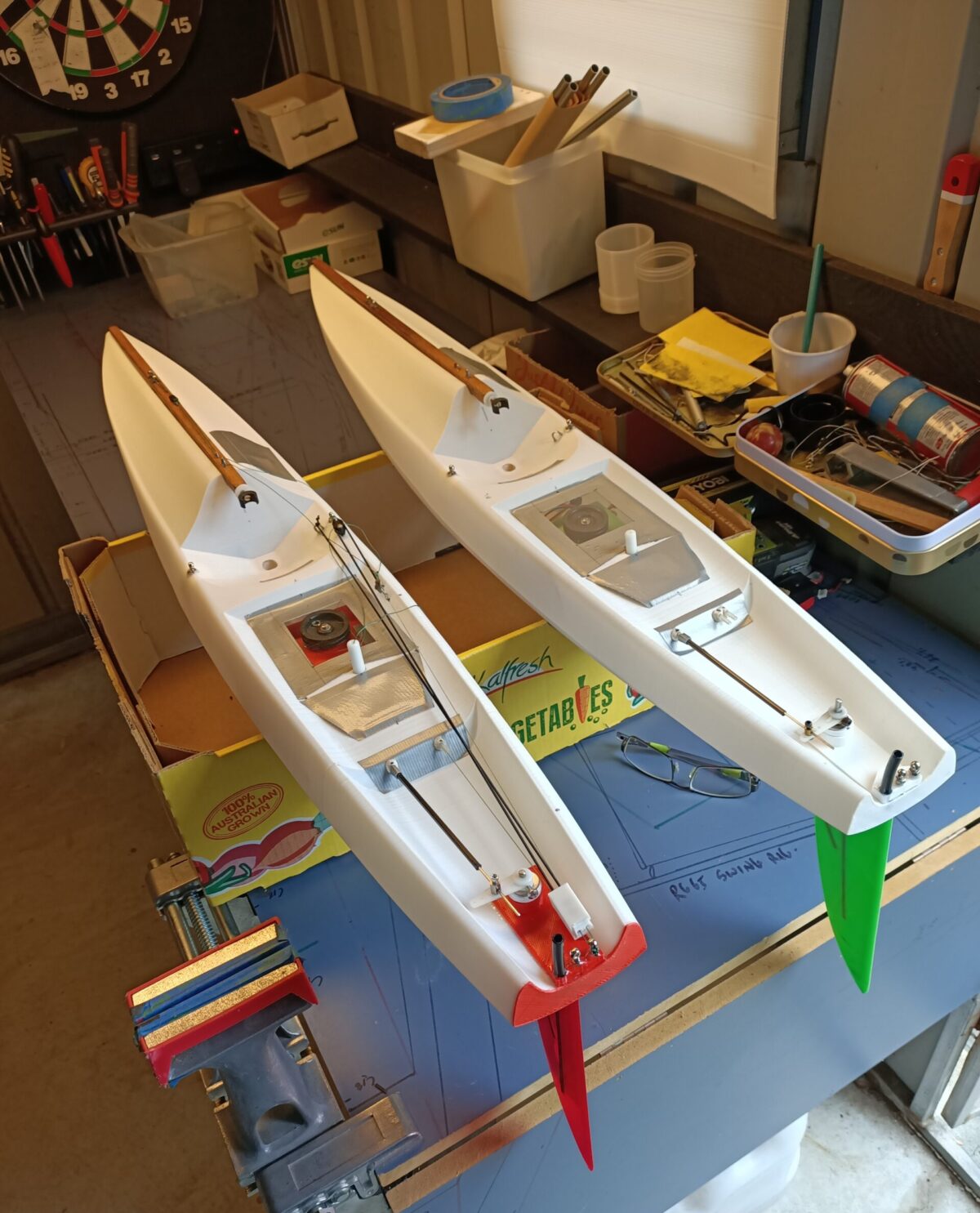

STL File Downloads: Print Your Own Yacht, IOM, RG65, 65 Class, Nano, Footy
print your own yacht: stl file downloads.
Welcome to the download site for files developed throughout this project and others.
These are many of the files that have been designed, printed and trialed in various radio controlled classes for 3d printing in small and large printers.
If you have any good designs you are happy to “float” to others here, please feel free to send the STL files to me at: [email protected]
Make sure your name is on the files so that you can be credited with their design.
All files supplied here are copyright free.
Note: these are all zip files and need to be downloaded as such.
And…probably a good idea to read through the notes here before you launch into the printing.
The basic items needed to produce a racing yacht are supplied, but things of a specialist nature will be up to you. In some cases there are multiple parts to choose from. For instance there is the Keel Box I use on my RG and there is also one designed for Dragon Force keels and bulbs… because there are a lot of them around and good for beginners to easily get into the sport. In fact the rig I have always used on my lovely RG (yes the design you have here) is taken straight over from a DF but using my own sails. There are multiple rudder tubes and open and waterproof servo supports to suite a variety of yachts also.
Plus the advantage of digital technology is that parts can be resized in the Printer software to fit other yachts. If you haven’t already done so, I strongly suggest you invest in what is considered the best and fastest 3d printer software package: Simplify 3D at www.simplify3d.com/
So if something doesn’t quite fit, just adjust on the 3d software. You don’t have to redesign from the beginning. Make it bigger, fatter, thinner….
All of the items listed here have been designed to be printed without 3d supports . Just change the orientation to find flat spot to place on the table. Hulls can usually be started from the bow or the stern, the deck angles are all determined to allow for solid 3d printing and no need for bridging.
If you see things on the images that are not in the files, it is because I most likely don’t use them any more. The latest versions have been thinned right down to keep the weight as light as possible. For instance I have stopped using pot surrounds because the new PLA+ (mentioned elsewhere) is very rigid and strong. Do yourself a favour and get hold of some to try out.
Please be patient with all this, things will evolve as time goes on.
A. Files from Bill Hagerup and Selwyn Holland
General Rudder design
Bulbs for you to resize to your yacht
Waterproof boxes for winches and servos
Nano plus bits and pieces
RG65/65 Class plus bits and pieces
Footy plus bits and pieces
IOM Sabre a lovely fast design
B. Detailed description of the pin, sheeting and deck layout
C. Files from other 3d printing radio control enthusiasts.
Happy to host your special files here .
General Rudder Design
This design was very early on in our research and turned out to be a great all round rudder. It has been used on everything from the Footies to the prototype 10R. Big advantage is simplicity of construction and you can vary the size to help fine tune the boat.
All I do is use a stainless core rod and a single solid carbon rod to add a bit more rigidity. All rudder printing is in “Vase” or “Spiral” mode (the same), this gives you a light hollow shell to work with.
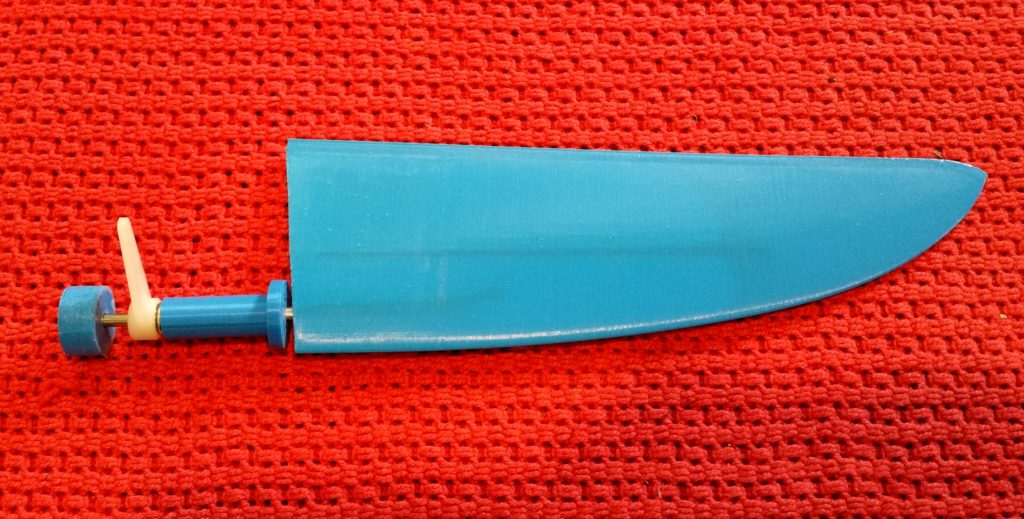
General Rudder size to fit any sized yacht (Hagerup Holland)
Bulbs for you to resize to your ya cht.
Both shapes appear to be efficient at the speeds we use in the smaller RC yachts. Fill them with the finest lead pellet you can source. Add a small amount of epoxy then some lead, let it settle, then repeat until full. Be patient, it takes time. I could not pick any difference in performance between these and a traditional lead bulb. Yes, there is more volume but you get an excellent shape and can determine the mass you wish before printing. Make sure there are no air bubbles left in the bulb, this gives unwanted bouyancy.
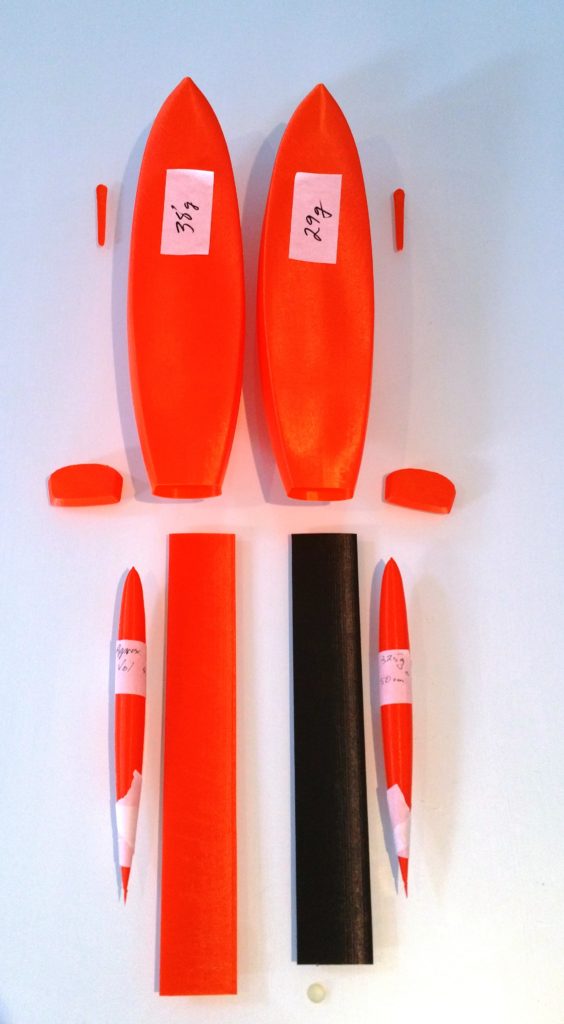
Bulb A (Holland)
Bulb B (Smith Holland)
About 18 months ago, I designed a set of waterproof boxes for the winch, servo and receiver in my yachts. These went through various stages of development as you would imagine. It is now very hard for any fresh or saltwater to get to the electronics, as a result my yachts have been completely free of electronic issues and corrosion. I still coated the exposed metal items with vaseline or similar long term oils before sealing and this acts as a second line of defence. I see all around me people having corrosion issues, but this appears to have solved the problem for me.
As an example supporting this move, I unfortunately had an incident that filled one of the IOMs half full of water due a few months back, lucky to get it back to the wharf. I drained the water out, went home and pulled the waterproof containers apart and there wasn’t a single drop of water in any of the boxes. A great result.
There are two sets
1. IOM and bigger yacht boxes .
They are all the same for convenience and set up for Guyat Winches and Hi Tech servos. Part of the easy “lego style” approach to the RC yachts. They can be kept together in what I call ‘The Stack” or glued in seperately, however you wish. Use them for your other designs, why get you electonic bits wet if you don’ need to.
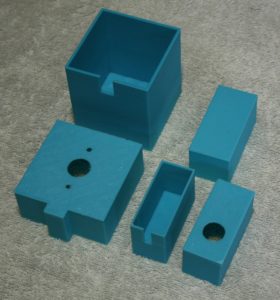
Please note. Depending on your 3d flow set up and nozzle size, you may have to play around with some resizing to get the boxes to fit each other smoothly.
Box Winch base v7 63×63 2mm wall (Holland)
Box Winch base v7 63×62 1.5mm wall (Holland)
Box Winch lid v6 1.5mm thick wall (Holland)
Box Servo lid (Holland)
Box Servo base (Holland)
Box receiver lid v1 (Holland)
Box receiver base v1 (Holland)
Box receiver lid v2 (Holland)
Box receiver base v2 (Holland)
2.Smaller Yachts: RG65, 65 Class, Nano, Footy
These yacht sizes tend to use the same servo type for both winch and rudder. So the set are the same… just make two of them and offset the vertical stack a bit to allow for the rudder horn to swing underneath the sheeting arm.

Box Servo lid v2 (Holland)
Box Servo base v2 (Holland)
Nano Bits and Pieces
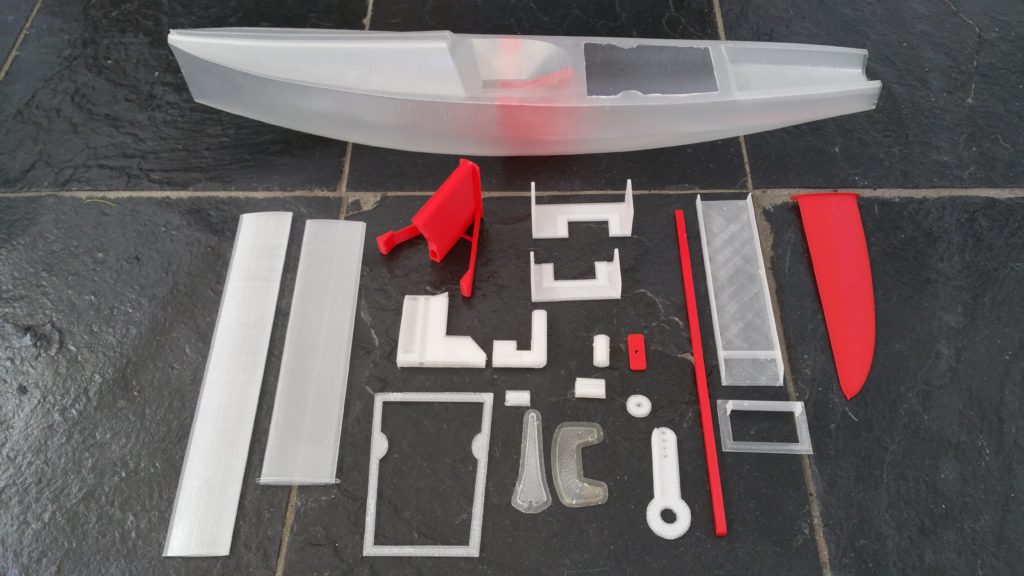
Nano Hull NanoSwing 2 (Hagerup Holland)
Nano Keel Box V8 Nano 40x4mm slot with supports and finished (Holland)
Nano Keel standard 300mm size to fit (Holland)
Nano Rudder (shrink to size) (Hagerup Holland)
Nano winch servo shelf blank Holland
Nano shelf modular v2 Holland
Nano rudder support 8mm diam round 3.3mm inside hole Holland
Nano rudder servo shelf blank Holland
Nano rudder deck washer 15x2mm 8.7mm hole Holland
Nano foredeck strut (Holland)
Nano back stay fastener (Holland)
Nano back plate (Holland)
RG65/65 Class Bits and Pieces
Dragon Force Keel version. The keel box was designed use a DF keel so anyone wanting to get into an RG65 quickly and easily could transfer their DF gear over and start sailing.
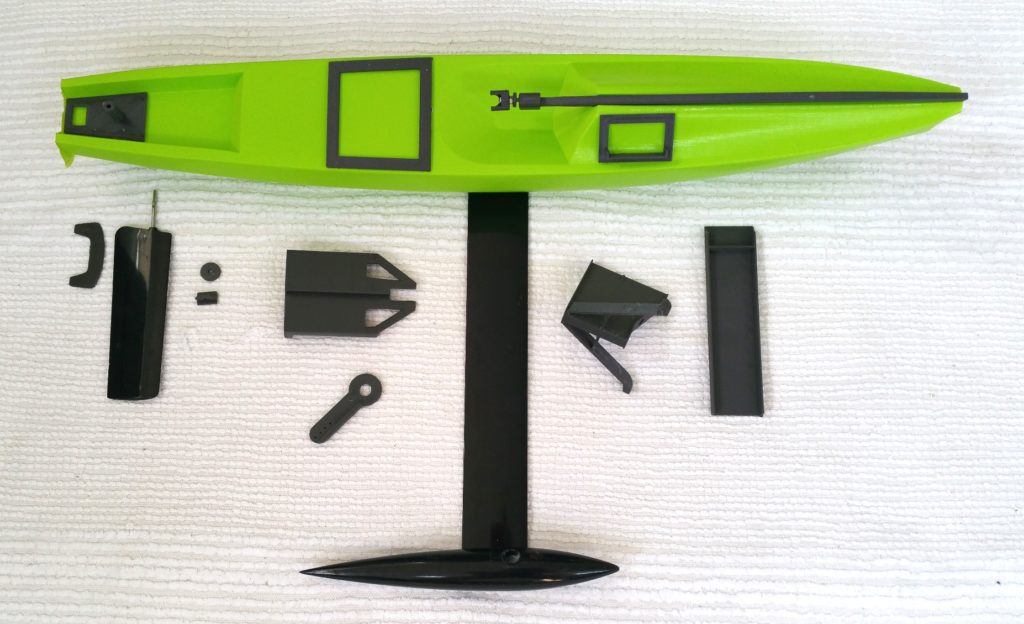
The Deluxe “Go Fast” set up with 3d printed keel, bulb and rudder. This is a more traditional RG65/65 Class design with a keel to fit. Use carbon rods down the middle to give it stiffness. Fill the bulb with fine lead shot and epoxy mix (bit at a time). A bit more volume but the shape is very efficient and I can’t tell any performance difference between this and a lead bulb. Size the bulb on your 3d software to get the exact mass you want.
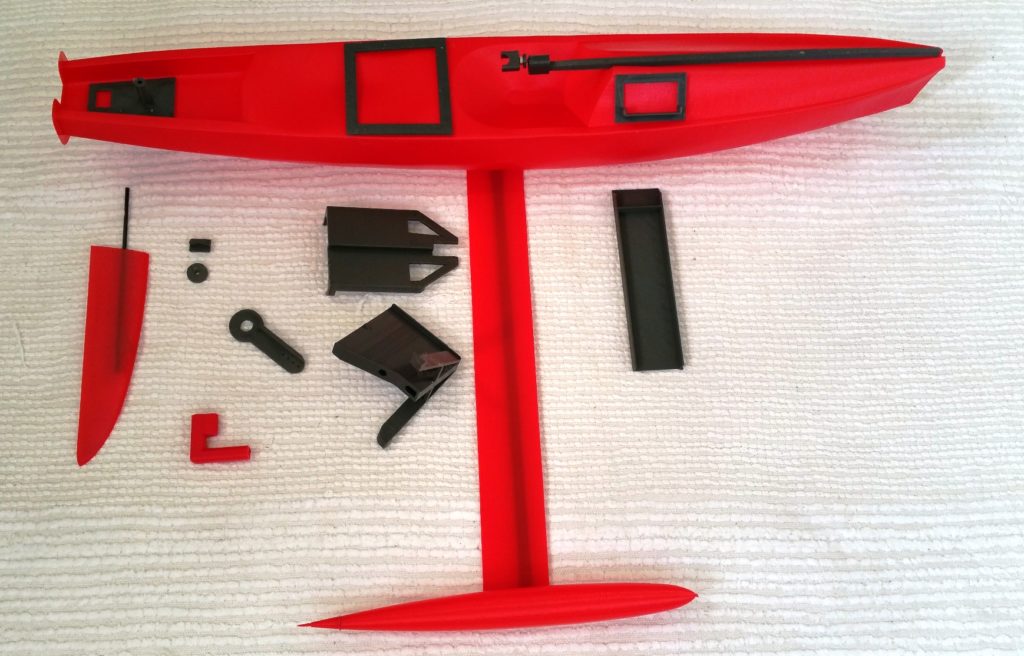
RG65 Hull Alpha Sabre (Hagerup Holland)
RG65 Keel Box V10 48x5mm slot with supports and finished (Holland)
RG65 Keel Box for Dragon Force keel V6 Holland
RG65 General Rudder file size to fit (Holland)
RG65 Winch arm Holland
RG65 Shelf V9 open blank stepped Holland
RG65 Rudder support internal 3mm hole x 10mm diam Holland
RG65 Rudder internal support 3mm hole Holland
RG65 Ram wheel Holland
RG65 Ram mast clasp Holland
RG65 Ram Holland
RG65 Glue pot v2 20x10mm Holland
RG65 Box Servo lid v2 waterproof change to fit base Holland
RG65 Box Servo base waterproofchange to fit lid Holland
RG65 Foreword support strut v2 tappered 4mm hole (Holland)
RG65 Back stay fastener (Holland)
RG65 Back plate (Holland)
Footy Bits and Pieces
The Footy is one of Bill’s favourite yachts.
These two hulls represent the final stages in our research for an optimum hull shape and lightness for these little fellas. The main differences is around the bow, the “submarine” was designed for quick recovery and less “tripping” when knocked down while running … they seem to spend a lot of time under water going down wind because of their huge sail area to water line length.
The other hull is a more traditional shape with a sharp tumblehome. Try the difference and let us know what you discover.
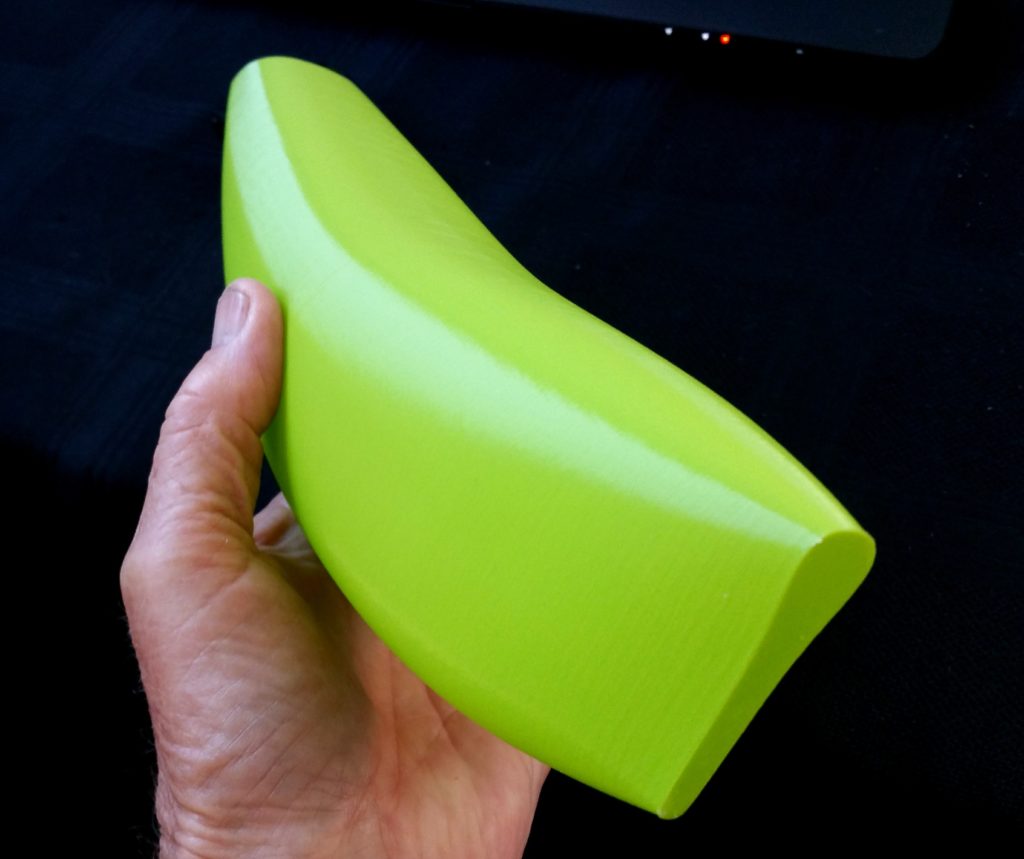
The above hull is an example of what can be done with a smallish printer. Bill Short produced the two parts of the hull seperately using the printer software and then sleeved them together. Very nicely done for his first attempt. The other “bits” also came out nicely. The Footy is a great sailing yacht and an easy one to start with.
Hull FootySwing2 v2 (Hagerup)
Hull FootPrint6. submarine bow (Hagerup)
Footprint Rudder1 (Hagerup)
Footprint Fin (Hagerup)
This is the latest IOM prototype from a longish development period going back over two years. As stated elsewhere, we were very reluctant to release a design until the right material had been found (PLA+ from esun) and the boat was competitive.
So, introducing the Beta Sabre from Bill Hagerup . I’ve been sailing this design since mid 2018 and love it. It seems fine across the spectrum of conditions from short chop, long wavelength and flat ponds.

Beta Sabre 3D (N0. 46)
I hope you enjoy it as much as I am.
In combinations with the waterproof boxes shown earlier, almost all the bits and pieces you need are here as STL files. You will need to make your own 10 mm thick bumper and create a stern or bow plate by printing 4 or 5 layers of a hull and stopping to give you the shape to glue in place.
Don’t forget the “lego” nature of all this, please feel free to use the fittings for your other yachts as you wish. They are all copyright free and we are gifting them to the RC community to help promote our beautiful sport . We will all win from you guys going out there and making this all happen.
I have often read: “When All Else Fails…. Read The Manual”
Well we don’t have a manual here, so how about: “When All Else Fails… View The Construction Pictures”.
Rather than try to explain everything, have a good look at the set of images below showing the various key construction processes. If you are unsure, please feel free to ask at: [email protected]
The STL files are at the end … yes you may need to do some minor resizing as needed. This is easy through a program like “Simplify 3d”.
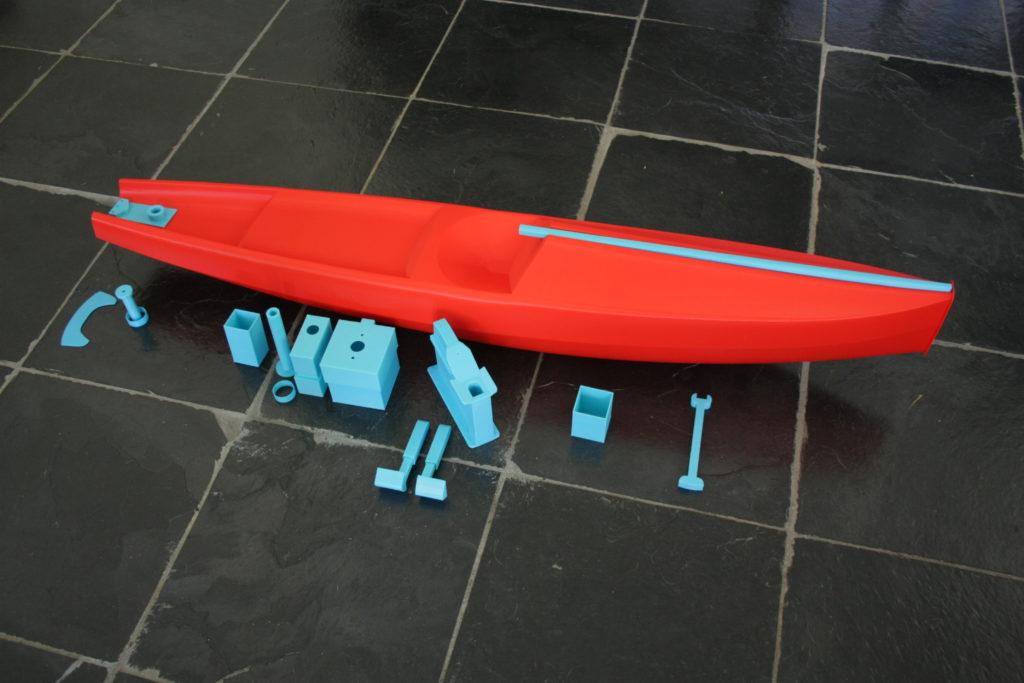
This is what you get to make the following:
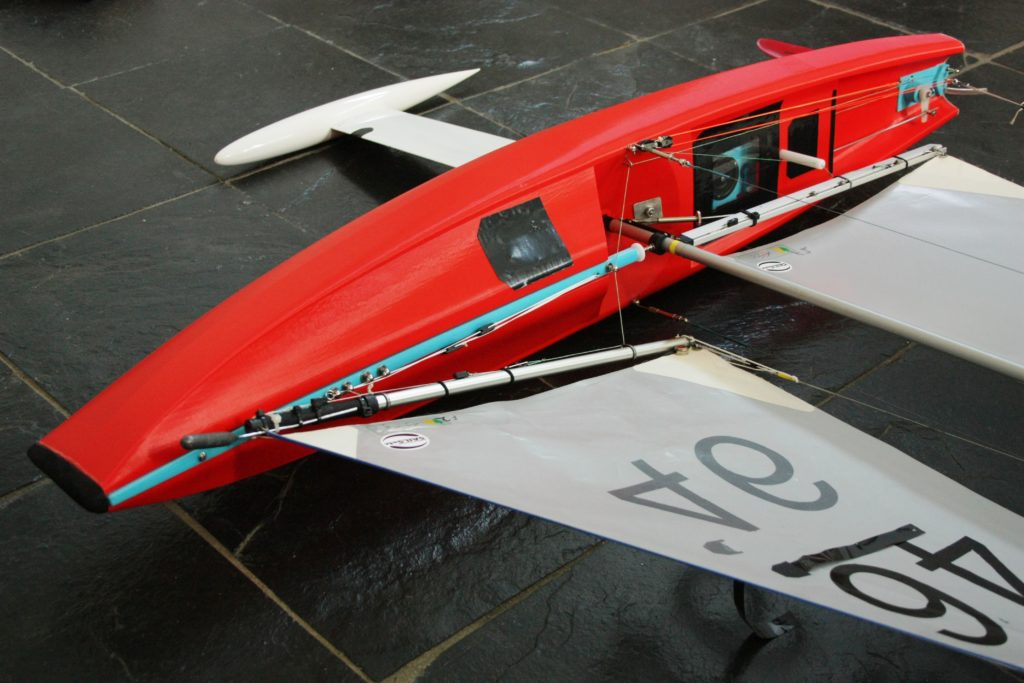
A couple of things to be aware of:
- The keel is designed around the latest Craig Smith fin design. If you can’t get this keel and have another, no problem, just work out you dimensions in cross section and change the slot profile until it fits. Then trim you keel head to fit inside the box. The last item is to fit the holding bolt in the right spot.
- The keel box support struts are telescopic to make them easy to install. Follow the pictures to see how it is done. To hold them in place I bend a small strip of PLA and add to the sliding section to give some tension to hold the head in place before the gluing.
- When using epoxy, add some filler until it is slow to flow. This helps strengthen the adhesion. Straight epoxy is not as good by itself. Also prepare the surface by rubbing with methylated spirits (ethanol) to remove the slight greasy surface that comes with 3d printing then sand both surfaces with a relatively coarse sandpaper. Try to keep the epoxy volume to a minimum. The PLA+ and epoxy adhere strongly.
- The boat appears to be nicely balanced with the battery pack ahead of the mast as shown. But it is up to you how you wish to set all this up.
- The rudder rod and sheet are run through the false transom at the stern. Once the position of the hole is worked out and made, I use vinyl tape (not insulation tape) to add extra support for the movement. I did this originally as a short term solution and have been using it ever sense. Easy and waterproof.
- When cutting and creating holes in the this PLA+ run the Dremel or drill at the lowest possible speed to stop the plastic from melting. This material cuts very nicely. I use heavy duty scissors for flat sections.
- Main pot size : 95x80mm (to allow the keel box to maneuvered and turned in there to put into place plus room for the waterproof servo and winch boxes)
- Battery pot size : 40x43mm (to allow the battery box to be epoxied to the hull… if that is where you want it)
- Receiver pot: 35x35mm (just big enough to get the receiver box in there)
- Wait until you have the keel installed before setting the rudder. This means you can install the rudder exactly parallel to the keel fin. Allow a slightly larger hole at the top of the deck to give you the option of lining up the rudder to the keel… however you do that, clamps etc.)
- When attaching eyelets and deck fittings, I run a few drops of epoxy into the hole before screwing/inserting the item. Any items with stress on the deck (ie sheet return) should have support underneath. The sheet layout I use is basic but but very effective and you can see this in the photographs. Again up to you.
- Most will almost certainly be slicing and sleeving in some shape or form depending on the printer. I’ve added some images showing how to sleeve two sections together. The sleeve is made by printing a section of the hull (30-40mm wide) and then cutting a small slice out to allow it to fit neatly inside the two sections.
- Finally, the blue Sabre below is 160mm wide and the red Sabre is 170mm wide. I also have a 145 mm wide one. Which is the best? In waves and short chop, the wider ones appear to be better but in light air on flat water, the narrow one seems to be faster. The beauty of digital files is you can choose your width and dial it up on the 3d software. Let us know what you discover.
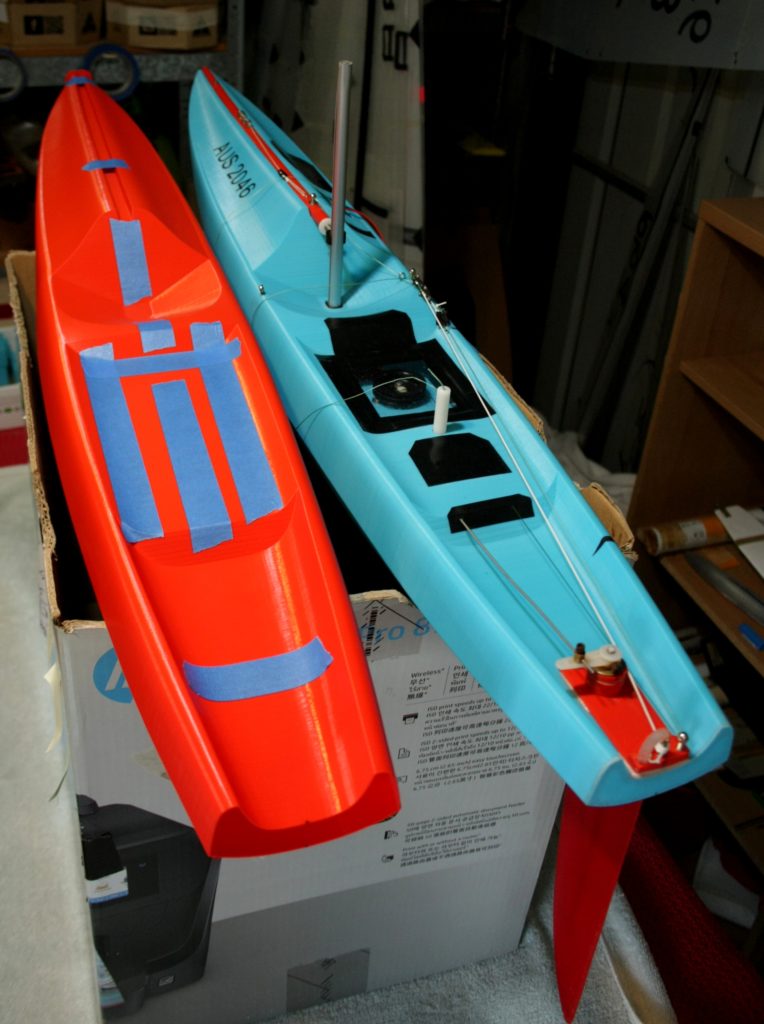
Before and After
Dremel cutting tools are worth their weight in gold. Remember to run the cutting tools and drills as slow as possible to stop melting the plastic. PLA+ cuts easier than normal PLA.
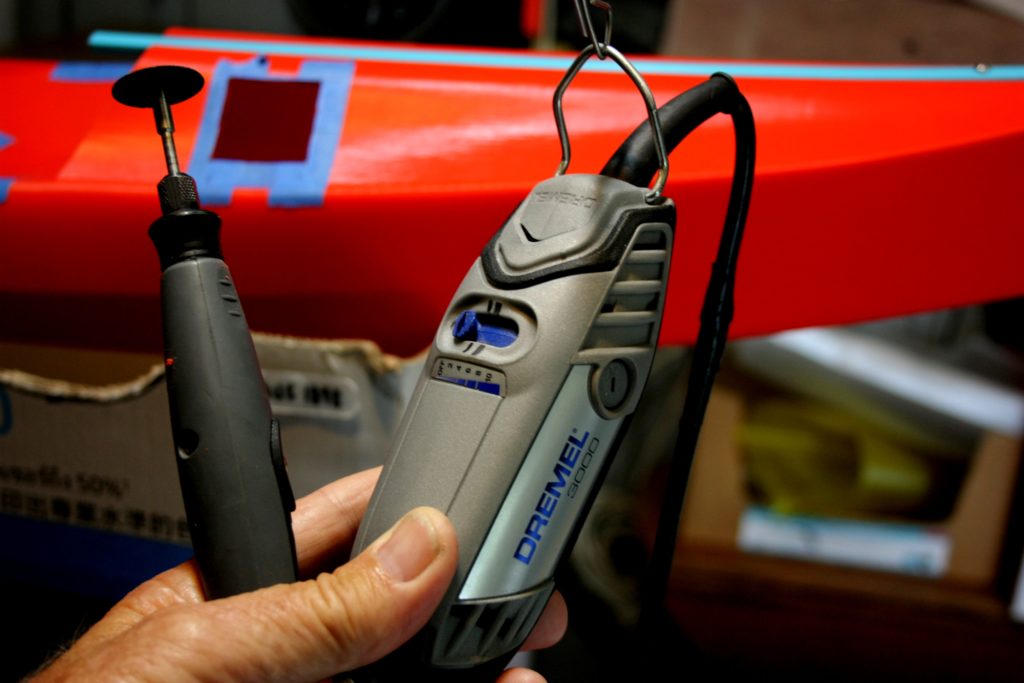
How to get the Keel Box in.
- Place a layer of epoxy on the hull floor ready for the base of the box
- Enter box down at an angle
- Slide into the hull
- Turn around
- Lift up into the position to slide forward
- Lift the deck carefully to allow the Keel Box to slide forward into place.
- Place the spring loaded struts into place at 45 degrees.
- Epoxy all in place

Multistep drills are very useful when creating holes on the deck

Sleeving is an easy and strong way to get sections connected. Simply print a section either side of where the join will be, then cut a small slice out to get it to fit inside the two sections. Alternatively, shrink the sleeve a tad until it fits neatly inside without cutting a slice. Finally, epoxy together.
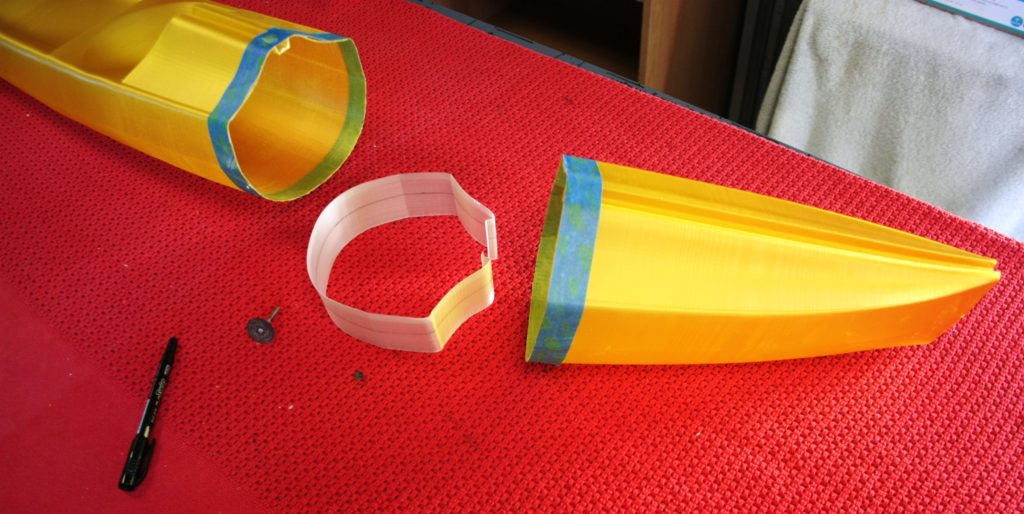
Making the rudder . This image shows the bent internal 4mm rod and the carbon tube insert to add to the stiffness. The rudder shell was formed using the single layer “spiral” mode.

The finished product.

Hull IOM BetaSabre V3 (Hagerup Holland)
Keel box v8 (Holland)
Stern plate v4 (Holland)
Rudder shaft tube 4mm shaft v2 (Holland)
Rudder increase size to fit IOM (Hagerup Holland)
Keel case support strut lower section telescopic v1 (Holland)
Keel case support strut upper section telescopic v3 (Holland)
Glue pot v2 solid 20×10 mm (Holland)
Box for battery v2 (Holland)
Bow internal strut v3 fitted base and top (Holland)
Bow external strut v5 horizontal 461x8x10mm tapered (Holland)
B. Detailed description of the pin, sheeting and deck layout
This description is for the IOM Sabre 3D. Just scale the process down for the smaller RC yachts.
First, if you haven’t please make sure you print with PLA+ from Esun. You should be able to secure a supplier either in country or internationally.
OK sizes for fittings. I use very basic layouts, and therefore rarely have things go wrong.
Front pin for A rig jib swivel depends on where your sivel is on the boom. The pin is 310mm from the front of the mast, this gives a small clearance to swing past the mast.
The sheet post is approximately 210mm behind the mast in the centre of the deck and set in a tube secured to the bottom of the hull.
The side stays are just behind the mast on the sides and and in line with the front edge of the keel. Please make sure you secure all pins with something solid below the deck… I glue three or four layers of PLA sheeting underneath with superglue if I can’t get the pin down through something solid like a strut. Drill a slightly undersized hole for the pins, test screw them in then remove and then drop a small amount of epoxy into the drill hole before finally securing them. Works well, nice and strong.
The rudder shaft is 55mm from the stern in the centre of course. Backstay pin is set in the backplate at the stern. The sheeting and rudder shaft are run out through the 45 degree bulkhead at the rear through deck and a sheet of sticky back or high quality insulation tape. The tight fit keeps it all water tight. They really do work, the trick is lining up the holes to set them straight through… good luck, a bit of thinking required there.
The sheeting is swivelled (returned) at the stern and starboard side stay. The side stay has two pulleys, one for the sheet and the other for the elastic for tensioning. This is a basic layout that works well and is mostly above deck to see if anything is going wrong.
Images attached below to help you visualise this.
That is the system I use for the Nano, RG65, 65 Class, IOM and 10R. The only differences are the dimensions.
Good luck and hope this helps.
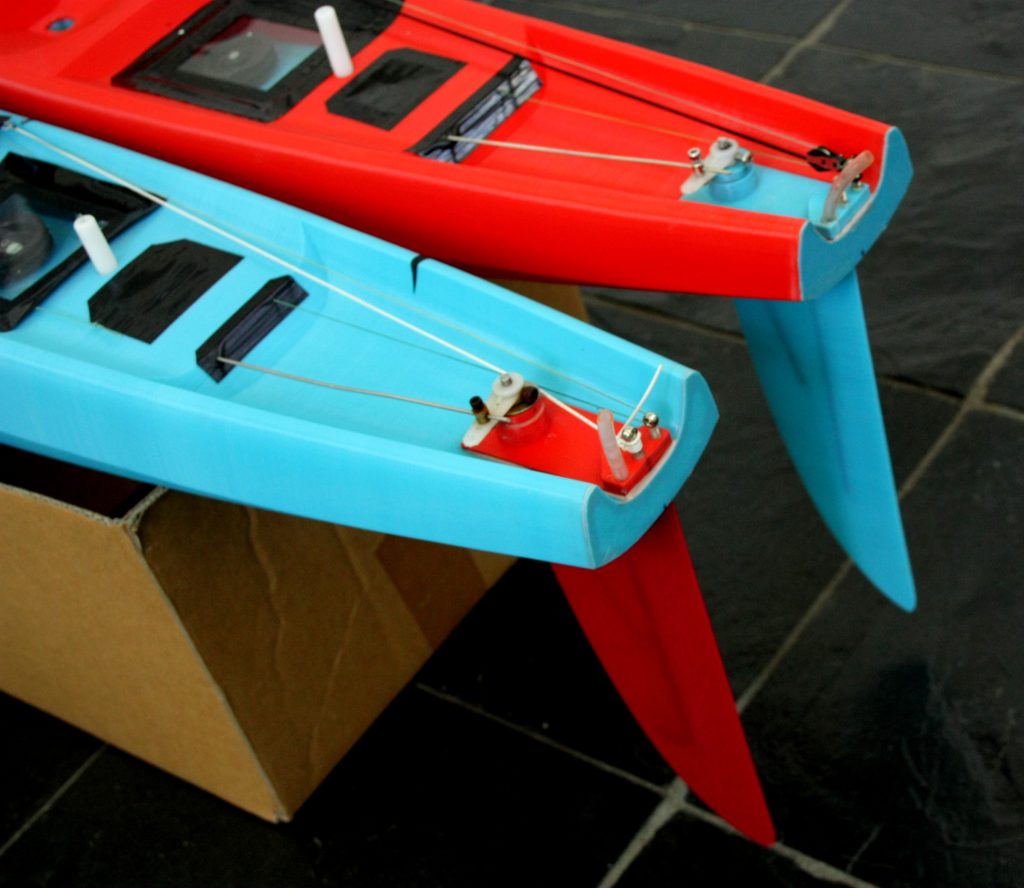
Happy to host your special files here.


7 Best 3D Printed Boats in 2023
Written by: 3DSourced
February 20, 2024
3D printed boats have seen a lot of developments in recent years, and have yielded some impressive results, overall showing a lot of promise for exciting and environmentally friendly vessels.
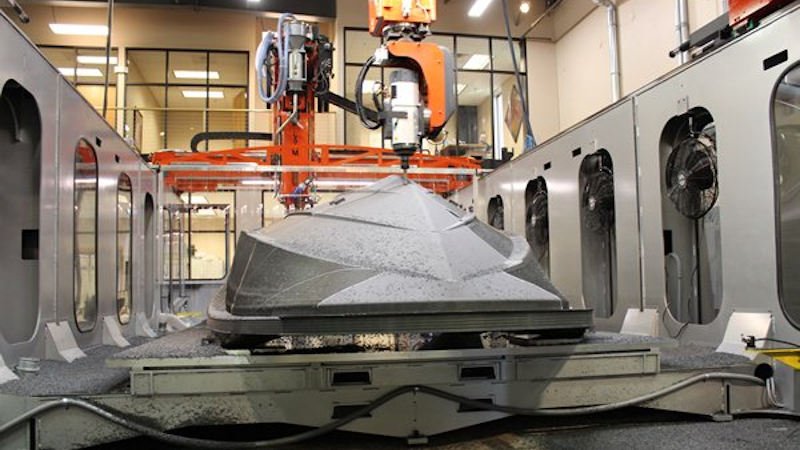
In this guide I’ll be showing you some of my favorite examples of companies making huge waves in 3D printing boat technology, everything from upcoming luxury liners to customizable sloops made from recycled materials.
Solvit3D – 3D Printed Boat Parts
Top 3d printed boats projects, 3dirigo – the largest 3d printed boat from the university of maine.
- Company: University of Maine
- Price: Not For Sale
- Where to Learn more: 3Dirigo and Guinness World Records Official Site
University of Maine Composites Center research team broke three Guinness World Records with 3Dirigo, the largest 3D printed boat to date , weighing 2.2 tonnes and measuring 7.62 meters.
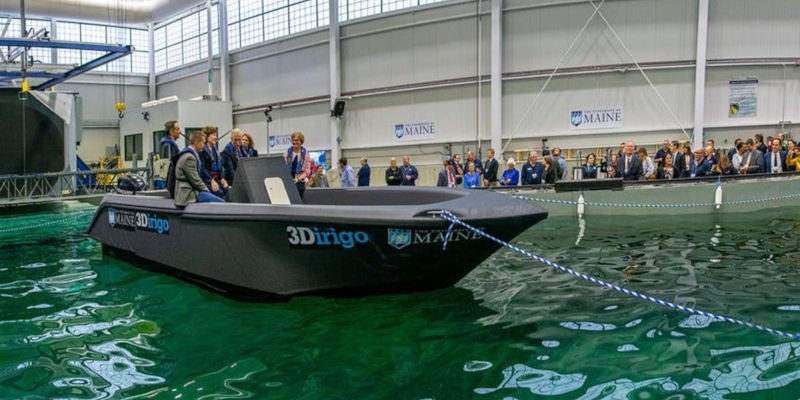
Created in just 72 hours with a plastic-wood cellulose mix, this milestone was achieved using a 3D printer developed in partnership with Ingersoll Machine Tools. This wasn’t the only example of such a partnership, as the University of Maine’s Advanced Structures department has since worked in military equipment development in 2022 .
Capable of additive and precise subtractive manufacturing, the printer can prototype for defense, civil, and infrastructural applications. With a capacity to print objects up to 100 ft long, 22ft wide, 10ft high, and a rate of 500 pounds per hour, UMaine has found itself a real game changer.
The same 3D printer drew the attention of the US Army Combat Capabilities Development Command for deployable shelter systems production, with the UMaine presenting a 3D printed army communication shelter alongside 3Dirigo.
Tanaruz Boats – Customized 3D Printed Boats
- Company: Tanaruz
- Price: $16,000+ (Price varies depending on model and customization options)
- Where to Buy: Tanaruz Boats
One of the biggest advantages of 3D printed boats is customization. Dutch start-up company Tanaruz offers fully personalizable 3D printed boats made to order via their app.
From this app you can select the model, shape, color, and even engine type to get exactly the boat you’d like using additive manufacturing to maximize efficiency and precision.
With the cost-cutting advantage of 3D printing, the Tanaruz team makes their boats very affordable for most customers without sacrificing quality. For just a €500 (~$556) deposit, you can reserve your dream 3D printed boat.
Pegasus 88m – The Carbon-Neutral Superyacht
- Designer: Jozef Forakis
- Price: Not Yet Released
- Where to Learn More: Pegasus 88m
The Pegasus 88m is a 3D printed ‘superyacht’ that even in 2023 only really exists on paper, but is still well worth talking about. Designed as a completely carbon neutral 3D printed luxury boat, it was conceived with nature a the forefront of designer Jozef Forakis’ mind.
Solar powered panels power electrolyzers that convert seawater into hydrogen, which is then stored in long-term tanks for later fueling. This means the Pegasus 88m can harness the power of the ocean for theoretically unlimited power, removing the need for fossil fuels entirely.
The Pegasus 88m is designed to look like a cloud as it floats on the water. Using a clever mirrored design, the idea is for the frame to reflect the ocean and great the illusion of invisibility.
While still a work-in-progress, we recommend keeping an eye on this exciting, albeit likely unaffordable, 3D printed boat project.
Hydra – The World’s First 3D Printed Aquatic Drone
- Company: AI Seer Marine
- Learn More: Naval News
UAE company AI Seer Marine specializes in unmanned boats, and they unveiled the final version of their 3D printed vessel, Hydra, in 2023.
The 5 meter (~16’ 5’’) Hydra is effectively a proof-of-concept that additive manufacturing can play a key role in boat construction. AI Seer Marine uses the lightweight nature of 3D printed frames and parts to enhance speed and efficiency as well as cutting costs along the way.
The project has been underway for some time, and only recently been unveiled as close to finished. You can see the first active trials of the Hydra’s prototype below.
Those of you familiar with boats will recognize the Hydra employs a ‘stealth’ shape, intended for use in naval ISR (intelligence, surveillance, and reconnaissance) missions. This means that it likely won’t be available for sale, but it’s still a cool project to keep an eye on.
Autonomous Ferry – 3D Printed Ferry For Paris
- Companies: Roboat, Holland Shipyard, and Sequana Développement
- Learn More: Holland Shipyard
The collaborative effort of innovation partners Roboat, Holland Shipyard, and Sequana Développement has born this concept for the autonomous ferry designed to carry tourists and athletes along the Seine river in Paris in preparation for the 2024 olympics.
The model builds on previous Roboat builds of self-sailing and docking passenger vessels in Amsterdam, as you can see in the video below.
Offering visitors and locals alike a unique and futuristic experience in small-scale aquatic travel, the three companies hope this ferry will showcase enough features to be a great step in the future of 3D printed autonomous boats, possibly even replacing bridges.
The companies are being quite secretive about their 3D printed ferry so far, but Olympics-goers are looking forward to experiencing the boat for themselves. And at a planned size of 9 x 3.9m (29.5 x 12.7′), it promises to be the world’s largest 3D printed autonomous ferry ever made.
Impacd Boats – Sustainable 3D Printed Sloops
- Company: Impacd Boats
- Price: $40,000+
- Where to Buy: Impacd Boats
3D printed boats don’t have to be big and flashy, they can also be simple but effective crafts to handle small-scale sailing. Impacd Boats offers customizable 3D printed sloops as comfortable and easy-to-ride boats for any lazy river fan to buy and enjoy.
The main mission is tackling carbon emissions and making a positive impact on environmental health. Their boats are 3D printed using recycled waste material, and even the decorative items included with their models are from sustainable origins.
Impacd Boats took inspiration from data taken from TU Deflt research into sustainability in aquatic travel , and developed a greener, more environmentally friendly construction process using additive manufacturing. Each boat even features an energy-efficient motor that is as silent as they are safe.
They only have two models available at the moment, but are working on the technology to release different kinds of sloop at affordable prices for anyone who wants to discover how to sail guilt-free.
- Designers: Alexander and Roman Schmidt
- Price: $1 – $16,694.85
- Where to Buy: Solvit3D
3D printed boats are exciting, but 3D printed boat parts are making just as much of a difference. Solvit3D specializes in 3D printed objects like boat parts and decorations, offering over 60 different examples from light fixtures to compass covers and even custom switch panels.
Brothers Alexander and Roman founded Solvit3D after discovering additive manufacturing’s ability to create complex geometrical shapes with speed and ease. The parts are light and highly customizable for any taste or any boat.
While they don’t 3D print entire boats, Solvit3D should be bookmarked by any sailing enthusiast for practical replacement parts and aesthetic upgrades at very reasonable prices.
Advantages of 3D Printing in Boats
3D printed boats have several key advantages including less waste, lighter weight, quicker and cheaper repairs, and lower carbon footprint.
Reduced Waste
Traditional subtractive boat production, such as CNC milling, results in a lot more waste than 3D printing , making additive manufacturing a more cost-effective and sustainable process.
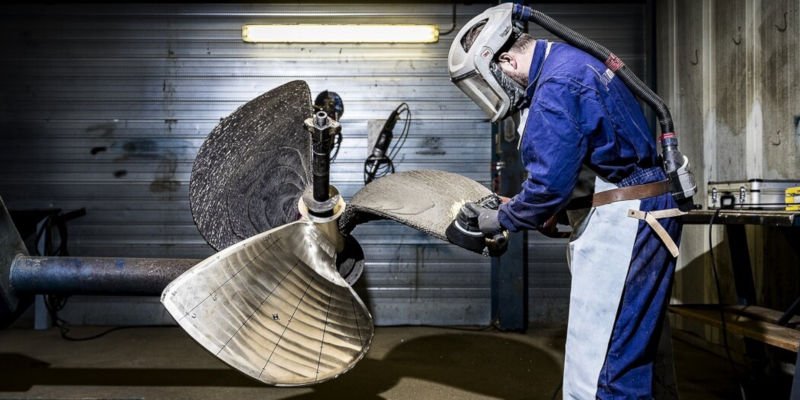
It’s also worth mentioning that some woods used in boat production are unsustainably, and sometimes even illegally, sourced , further adding to the need for alternative materials and manufacturing methods.
Research in the sustainability measures in boatbuilding carried out in 2021 shows some frankly alarming statistics . Only 55% of companies have a sustainable sourcing policy for their building materials, while 40% claim to not have the budget to research or implement more environmentally friendly construction methods.
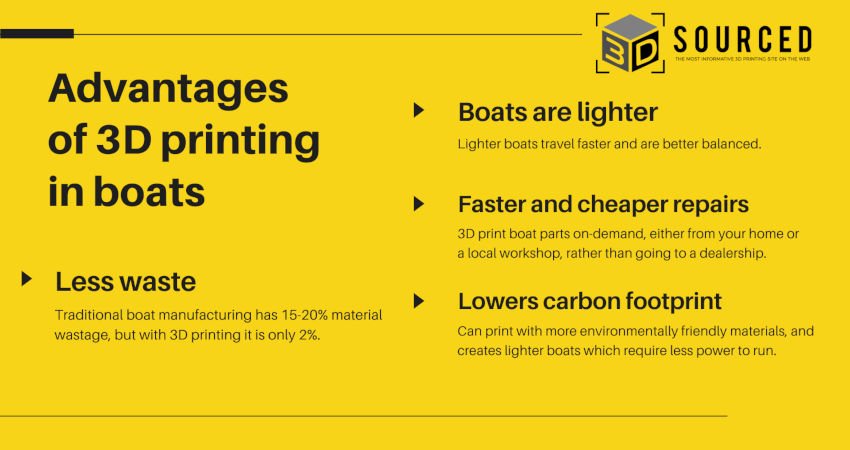
Lighter and Better Balanced Boats
Additive manufacturing yields boats that are lighter, faster, and better balanced due to the use of 10-30% infill . Projects like Rammses predict 3D printed boat propellers weighing 40% less than conventional ones. By 2030, lighter titanium could replace steel in yacht production.
Efficient Repairs
3D printing can expedite and reduce the cost of repairs by producing spare parts on-site , a strategy already utilized in the automotive industry.
Lower Carbon Emissions
3D printed boats are more environmentally friendly due to research into lighter, more efficient materials like aluminum alloys for propellers , which can be printed anywhere to minimize transportation.
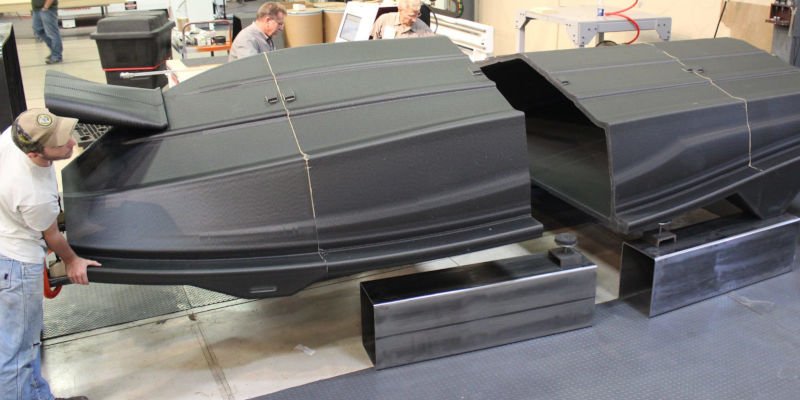
This innovation is crucial for the maritime sector striving to reduce carbon emissions and waste material through CNC machining. Searious Business, a Dutch association fighting against plastic pollution, even plans to print a 3D boat from plastic waste like Impacd Boats are.
Future of 3D Printed Boats
The boat design industry’s future includes a growing shift to 3D printing, resulting in cheaper, better-performing, and more eco-friendly vessels. The technology will revolutionize the industry by 2030, according to expert Gregory Marshall , with potential applications ranging from self-driving canal taxis to futuristic super yachts, as seen in the innovative 3Dirigo project.
Was this content helpful? Give us your feedback here.
Learn More About 3D Sourced
Exceptional Value with AnyCubic’s Latest 3D Printer Deals

11 Best 3D Printers in 2024 (All Budgets)

The 6 Main Types of FDM 3D Printer Explained

5 Best 3D Printers for Miniatures & Terrain in 2024
The 56+ Coolest Things To 3D Print in 2023

44 Common 3D Print Problems – Troubleshooting Issues 2023

13 Best Free 3D Modeling Software (For Beginners) 2024

6 Best Large 3D Printers in 2024 (All Budgets)

4 Fastest 3D Printers in 2024 (All Budgets)

5 Best 3D Printers For Beginners in 2024

40+ 3D Printing Industry Statistics (2024 Update)

22+ Coolest 3D Printed Robotics Projects (2024 Update)

8 Best DIY 3D Printer Kits in 2024 (From $150!)

3D Printing In Space – Top Projects in 2023

Best 3D Printed Shoes in 2023 (Sneakers, Heels & More)

The Best 3D Printer Buyer's Guide Resource & 3D Printer Reviews
[email protected]
3D Printers 3D Scanners 3D Software Guides Rankings Interviews News
Most Popular
Best 3D Printers Best 3D Scanners Best 3D Modeling Software Best 3D Slicers Best Resin 3D Printers Fastest 3D Printers Best Large 3D Printers
Useful Links
About us About the team How we do our reviews Careers Contact Us
Sign up to our newsletter
Privacy policy
Affiliate disclaimer
Editorial policy

The global authority in superyachting
- NEWSLETTERS
- Yachts Home
- The Superyacht Directory
- Yacht Reports
- Brokerage News
- The largest yachts in the world
- The Register
- Yacht Advice
- Yacht Design
- 12m to 24m yachts
- Monaco Yacht Show
- Builder Directory
- Designer Directory
- Interior Design Directory
- Naval Architect Directory
- Yachts for sale home
- Motor yachts
- Sailing yachts
- Explorer yachts
- Classic yachts
- Sale Broker Directory
- Charter Home
- Yachts for Charter
- Charter Destinations
- Charter Broker Directory
- Destinations Home
- Mediterranean
- South Pacific
- Rest of the World
- Boat Life Home
- Owners' Experiences
- Interiors Suppliers
- Owners' Club
- Captains' Club
- BOAT Showcase
- Boat Presents
- Events Home
- World Superyacht Awards
- Superyacht Design Festival
- Design and Innovation Awards
- Young Designer of the Year Award
- Artistry and Craft Awards
- Explorer Yachts Summit
- Ocean Talks
- The Ocean Awards
- BOAT Connect
- Between the bays
- Golf Invitational
- Boat Pro Home
- Superyacht Insight
- Global Order Book
- Premium Content
- Product Features
- Testimonials
- Pricing Plan
- Tenders & Equipment

Can 3D printing transform the way boats are designed and built?
From spare parts on demand to click-and-buy tenders, 3D printing is transforming how boats are designed and built, discovers Tristan Rutherford
Espen Øino holds a 3D-printed model of a yacht up to his laptop camera. “We use 3D printing for quickly printing out models to evaluate,” explains the celebrated naval architect. “The more you look at a virtual model on a screen the more you feel the need to physically touch it and feel how the hull shape is.”
Øino states that 3D printing “is going to revolutionise boatbuilding”. Circuitry could be printed inside a hull without cable trays. Local geometries and structural arrangements will not be based upon accessibility for a welder or engineer to do their job. “It’s really promising because once we have different printing heads with different materials you can optimise structures.” The timescale? “Don’t get too excited,” warns Øino. Printing entire superyachts are still some way off.
Last December the excitement was palpable as one of Scandinavia’s best-selling runabout models powered along Sweden’s blustery west coast. But this version of the 4.2-metre Pioner 14 Active was different. It had been printed in just three days, entirely in one piece. No moulds, no tools and minimal labour required. The build wasted just four per cent of raw material. The boat could have been printed in sky blue or shocking pink. The style-conscious Swedes chose black.
In the three leading yacht manufacturing nations of Italy, the Netherlands and Turkey, dozens of designers, shipyards and service companies are using 3D printers to create models, parts and entire boats in very different ways. It’s a fragmented market buzzing with ideas, yet one that’s breaking convention with every passing month.
Also last December, Rotterdam startup Tanaruz clicked “print” on the tender of the future. Tanaruz’s runabouts (from €15,000, and 4.5 metres to 7.5 metres in length) look like the eco-chic offspring Nike and Apple, with swooshing lines and ice-white interiors. The range envisions a voyage without fossil fuels. Solar panels are seamlessly integrated into the boat’s design and can maintain the digital display, trip data and 48V electric engines, which are backed up with a rechargeable battery. The company’s third hull, printed in March 2022, putters down the Rotte River at its top speed of six knots.
Tanaruz imagines a Tesla-like world without brokers too: models are customised via an app (toggle to vary length, colour, cushions and power pack) then delivered by truck two weeks later across Europe.
Naval architect and Tanaruz co-founder Alexey Shifman explains the allure. “With 3D printing, I don’t need welders or specialists with different knowledge,” he asserts. “I don’t need to build a shipyard; [all that’s required is] one or two people working around a printer.” In the 3D future, bigger boats won’t blow the budget. “With a GRP boat, if you go from five to 10 metres you need four times more people. If we printed bigger it simply doesn’t matter.”
Key to costings at Tanaruz is the company’s belief in a circular economy. Around 99 per cent of the boat is made from recycled polypropylene left by factories across Belgium, mixed with discarded glass fibre. Both waste materials are incredibly cheap. Its Track Motion printer made by Swiss-Swedish robot manufacturer ABB (the pricey bit at around €350,000) eats up to 30 kilograms of plastic flakes an hour, while building the boat layer by layer. Although a 500-kilogram, five-metre-long boat takes around 60 hours to produce, as printing curves and corners takes patience – even for a robot.
Here’s the fun bit. “We can shred and reuse each Tanaruz boat five times,” explains Shifman. “A client can recycle a boat back to us to reprint into one that’s bigger, smaller, a different colour or design for a small fee. It’s a closed circle.” With Tanaruz’s tech, it would be practical to change your little electric tender every couple of years.
Across the Netherlands, Feadship uses 3D printing to speed up the production process, says lead exterior engineer Jitze van Zelst. “More than 10 years ago we started with small items.” In particular objects that took too long to produce elsewhere or were tricky to procure by other means, like bespoke stainless-steel fittings for a railing. “On one recent yacht we installed 100 of these 3D-printed brushes for cabinet door knobs,” continues van Zelst. Feadship owns its own printers and a network of 3D-printing specialists. “In the future, crew might be able to print their own spare parts on board.”
Note that most yacht spares will have to be printed in metal, which comes at a cost. While a 30-centimetre-long resin printer can be snapped up for €2,500, a similar-sized unit to print in aluminium or stainless steel can easily touch half a million euros. Yet 3D-printing converts state that the process is like printing money. Firstly as there is so little waste, and secondly as so little material is needed because handrails, drains and other deck items can have an 80 per cent hollow latticework interior, thereby paving the way for lighter boats too.
The naval architect who can best envisage a printed metal future is Greg Marshall . “When we learned that GE was printing turbines, that was our big watershed moment,” remembers the Canadian yacht designer, who started experimenting with 3D printing around 18 years ago. “We flew down to Concept Laser [a German manufacturing company with a subsidiary in Dallas] and were just blown away by what they were printing in metal.” Marshall says that metal printers, the largest of which can currently craft an object around 75 centimetres long, are best used when designers wish to combine a huge amount of complexity with minimal material outlay. “My belief is that artists are going to rule the 3D-printed world,” because any shape is possible to produce. “We’re not buying this from a manufacturer. We can have [the design] suit the boat exactly how we want.”
There’s a second factor in the metal printing stakes. As materials are used so sparingly during the printing process, “in the next 10 years” printers might be able to produce an entire boat from titanium, which has the greatest strength-to-density ratio of any metallic element. “Because titanium doesn’t corrode, all of a sudden you can make tiny little pipes to do all sorts of things,” continues Marshall. These include “drain details in the decks themselves or miles and miles of cooling lines that take seawater, blow it through the boat, and keep all the decks cool.” The technology is already there to print hinges on doors or sinks in the heads, with the possibility to physically print wiring into a boat so that a shipyard doesn’t have to draw cables. To build a full-sized boat, “what you have to do is increase the size of the machine. That’s just a scaling thing.”
Printing in metal opens up other opportunities. “We can go down to three microns (.003mm),” explains Marshall. This creates the quality of production in terms of measurement and cutting that one might expect on an iPhone and a more complex finish possible than on a GRP-moulded boat. Better still, if a designer wishes to colourise their titanium prior to printing, a paint job could become a thing of the past.
What about the holy grail of 3D printing on board a yacht? “They just loaded [a 3D printer] on one of the big aircraft carriers,” he continues. “It’s not an inexpensive way to produce parts, but if you’re in Antarctica and you don’t have a choice…”
In Milan, printing experts Moi Composites have floated yet another 3D business model: bringing the latest printing deck directly to shipyards. The backstory is that three sea-loving scientists spent years creating their own specialist printing materials. These are mainly based around fibreglass, carbon fibre or Kevlar, mixed with a resin that solidifies directly after printing – imagine the world’s most expensive printer cartridge. Other firms have struggled with generic plastics. Their conventional printers melt coils of plastic that harden slowly and frequently get doused in the dust – a nightmare in terms of finish.
“Our materials are also much stronger and more lightweight, as well as resistant to chemicals and heat,” says Moi Composites’ chief technical officer Michele Tonizzo. To prove it, they printed a one-of-a-kind boat called MAMBO for the Genoa Boat Show in 2020. The vessel is a wave-like sculpture capable of 26 knots, crafted by robots that worked through the night to push nautical engineering to the limit. “It’s not supposed to look conventional,” says Tonizzo, but more of a showpiece of what 3D-printing technology can produce. “[ MAMBO ] is elegant, crazy, and it would have been impossible to achieve with normal methods.”
Could a shipyard send Moi Composites a set of naval architect drawings to print out? “We did a project with Sanlorenzo to produce parts for its newly designed boat and shorten the time to market,” Tonizzo says. “We are also enabling manufacturers to print parts by themselves by providing them with our 3D-printing system.”
Tonizzo claims that while he has the space to print an entire small boat “it’s better to install a machine directly at a shipyard where the experts are”. Potentially Tonizzo and his colleagues could test a yacht concept in Milan, tailor the machine to a shipyard’s needs, then transport it to Livorno or Ancona and train people how to operate it. The price of this? Tonizzo remains tight-lipped, but it’s likely to be similar to the price of a snazzy apartment in Milan.
Back in the Netherlands, Marnix Hoekstra, co-creative director at Vripack , enjoys a daily dose of 3D. “Earlier this week our team designed some railings,” he says. “We couldn’t decide on the scale so we just printed them off.” A webcam was recently positioned above the 3D office printer, allowing Vripack staff to print around-the-clock from home. “Recently we used it to print an art piece to install on a yacht that was impossible to make by hand.” The complete steering console of a yacht has also been 3D printed.
Hoekstra shows me a set of superyacht models that his colleagues have printed out. “Here is a 60-metre currently in build with Alia Yachts . Next to it is a sportsfisher in build with Royal Huisman .” At Vripack, blocks of each 3D model are printed then glued together – “a bit like how you build a ship,” laughs Hoekstra. By making precise printed samples, “three or four feet in length”, the Vripack team “can judge sheers, angles, the flare of a bow. You get a good visual compared to virtual reality. It’s an actual model.”
Will 3D printers be installed inside every engine room in future? “ Gene Machine , an Amels yacht, has 3D printers on board,” continues Hoekstra, as does the Nobiskrug Artefact , but he believes the process of printing tough-as-nails spares is “still a bit more talk than practice”. In the future that might change. “What everybody will find out is that the printing itself isn’t difficult because the machine does it.” Hoekstra believes that younger crews will be trained to use the tech. “We’re already seeing scanning apps on the new high-end phones,” he continues, which could photograph a broken bolt or propeller. “From that scan, it automatically transfers to a printable model,” which could be sent to a printer on board.
So will we see entire yachts printed with no moulds, little waste and few staff in the near future? “Yes, I have no doubt,” says Hoekstra. “They can print food, so there’s no end to the materials used to print. Anybody who thinks differently will be disrupted. With quality labour being so short, robots will take over many tasks.”
First published in the November 2022 issue of BOAT International. Get this magazine sent straight to your door, or subscribe and never miss an issue.
Similar yachts for sale
More stories, most popular, from our partners, sponsored listings.

- Subscribe Now
- Digital Editions

3D printed boats: Why this radical custom yacht is just the tip of the iceberg
- Top stories
Could 3D printed boats become the next big trend in boatbuilding? Vasileios Sofikitis explains all…
You are at home, sitting at your desk. In front of you, on your laptop, is a bespoke 3D rendering of the boat you’ve just finished refining online. You lean back gazing admiringly at your design. The detailed online forms took you a couple of days to fill in but the result looks exactly like the boat of your dreams. OK, time to print it out.
Wait, what? It reads like a scene from a sci-fi novel but this might well be the reality of how we will all go about buying and manufacturing boats in the not too distant future. The current GRP boat building procedure is a complex, time-consuming and expensive process with limitations on the type of shape and structures that are achievable.
It usually starts by handbuilding or milling and fairing a perfect full size model from which the female moulds for the hull and deck can be created. These moulds have to be carefully aligned, reinforced and waxed before the gelcoat and multiple layers of glass matting and resin can be added.
Article continues below…
Sharrow MX-1: This toroidal boat propeller could be top of the props
Welcome to the future: 5 futuristic yachts being built today, recommended videos for you.
This then needs time to cure at a precisely controlled temperature before the hull and decks can be removed and the whole cleaning and waxing process starts again. But this won’t be the process for much longer if the latest advances in 3D printing are anything to go by.
Meet MAMBO (Motor Additive Manufacturing Boat), the world’s first 3D printed fibreglass boat. It was launched by Moi Composites at the 2020 Genoa Boat Show in October. The Italian start-up drew inspiration from the Arcidiavolo design of British power boating legend Sonny Levi.
They spent almost six months running hydrodynamic simulations on Autodesk’s cutting-edge design and simulation software to refine Levi’s multihull before settling on a final design that takes full advantage of 3D-printing’s capabilities.
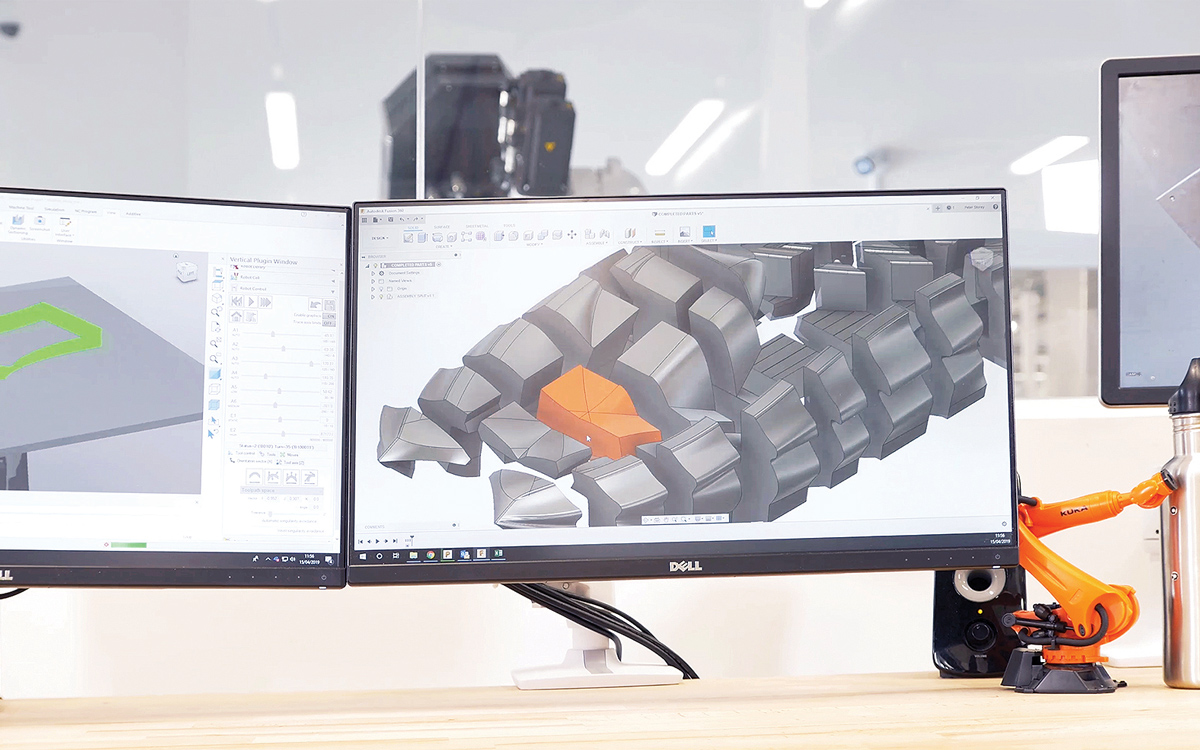
Software breaks the shape into printable sections
As a result, MAMBO sports some very unusual design ideas both above and below the waterline that simply wouldn’t be possible with the limitations of the moulding process (you have to be able to remove the moulding without destroying the mould).
MAMBO features a radical three-pointed hull featuring an asymmetrical deck layout and intricate organic forms that play a role in both its aesthetics and structural integrity. It measures 6.5 metres long by 2.5 metres wide and has a dry weight of just 800kg.
A relatively modest 115hp Mercury Pro XS outboard engine provides the power. The aft bench, the shape of which resembles a baby grand piano, is a reference to Mambo, the Cuban musical genre. These unorthodox design solutions not only help differentiate the boat from other craft on the water but also showcase the seemingly limitless possibilities offered by 3D-printing.
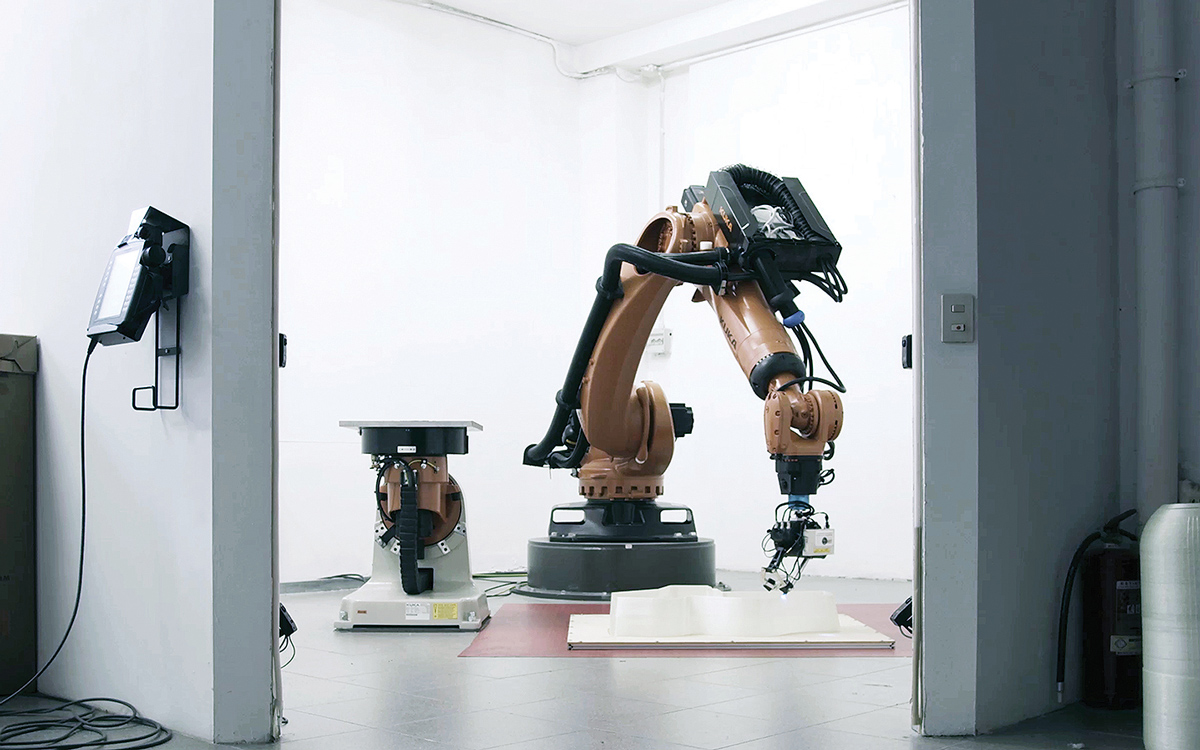
A robotic arm prints out each segment using a continuous glass fibre filament impregnated with thermo-setting resin that cures instantly
In order to print MAMBO, Moi employed an innovative, remote cloud-based workflow process that helped leverage the best talents and facilities around the world. Two separate printers, one in Moi’s headquarters in Milan and the other in Autodesk’s manufacturing facility in Birmingham, UK, jointly produced MAMBO’s components, demonstrating another advantage of 3D-printing — decentralised manufacturing.
MAMBO’s greatest innovation however, lies in its 3D printing technology. It uses a patented process known as continuous fibre manufacturing (CFM) that extrudes a continuous stream of glass fibre infused with thermosetting resin, which instantly cures under the printer’s UV lights.
This continuous glass filament creates an immensely stiff structure, resulting in a much lighter but more durable hull. The use of CFM minimises waste, enhances precision, and enables the creation of shapes that would be impossible or prohibitively expensive using traditional methods.
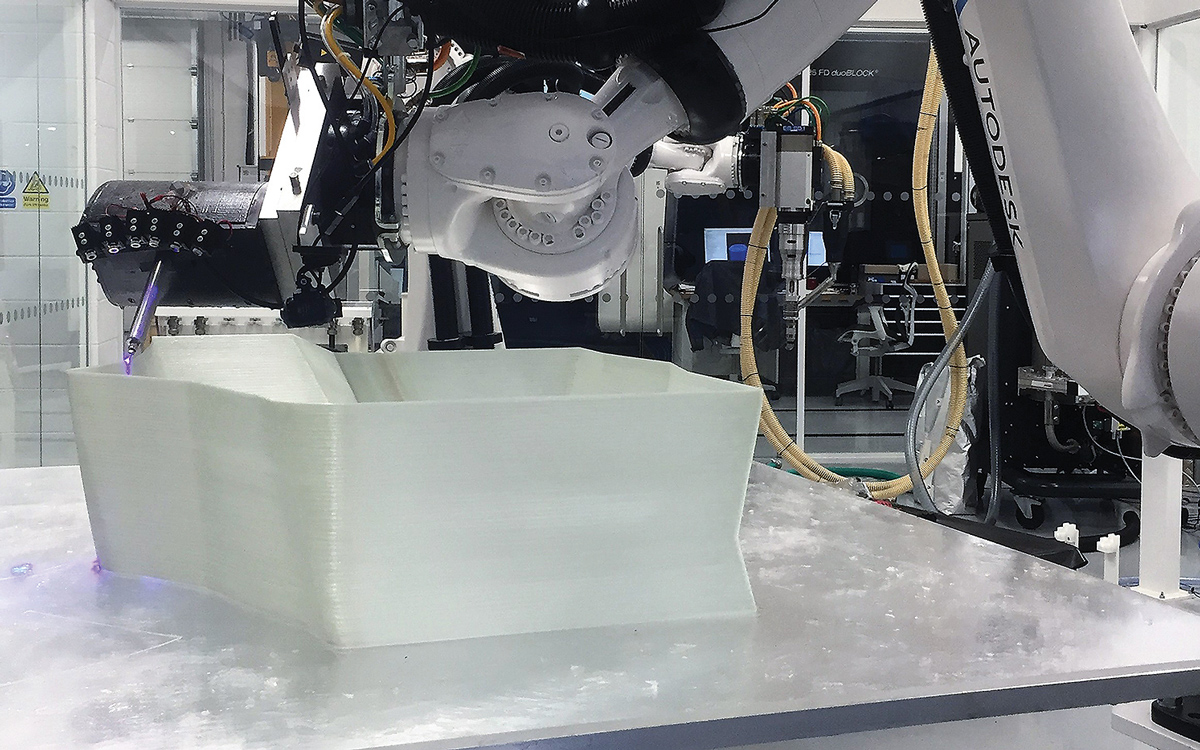
By repeatedly going over and over the previous layer it slowly builds up into a single finished 3D shape that is lighter, stiffer and more complex than a conventional GRP moulding
Once printed, MAMBO’s components were sent to Catmarine’s shipyard in Miggiano, Italy, for final assembly. Here the different sections were laminated together using glass fibre matting and polyester resin and painted electric blue. The deck was covered with eco-friendly cork and its seats upholstered in white leather.
MAMBO suggests that 3D printing will appear first in smaller sportsboats and day cruisers . As printers become larger and quicker though, we could start to see bigger boats manufactured in this way. 3D printing is already being adopted in other industries as an alternative to the traditional, more expensive methods of lost-wax casting or plastic moulding, especially for complex shapes and small production runs.
Many boatyards are also starting to use 3D printing for low-volume parts and rapid prototyping applications.
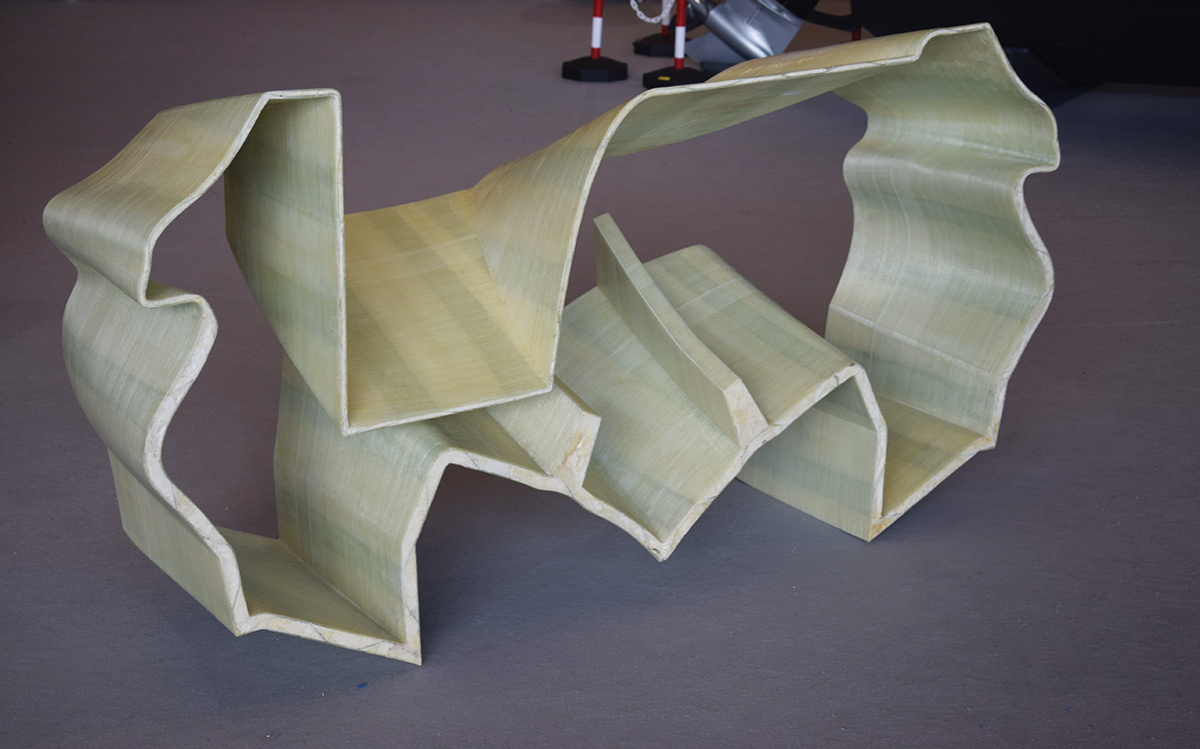
The individual sections were printed at two different facilities in the UK and Italy
Even boat owners wanting custom pieces or replacement parts that are no longer available are starting to look to 3D printing as a solution, with companies being set up to answer this demand. The Italian firm Superfici exhibited just such an example of their work at Genoa, an innovative steering wheel design prototyped on a 3D printer.
There are still some limitations to 3D printing when it comes to the size, cost and scalability of large items such as boats. The assembly of many small components and the need for post print processing pose a challenge. The variety of materials used in boat-making, such as wood and stainless steel, neither of which are yet printable, also present problems. However, projects like MAMBO prove that most of these problems will eventually be solved.
When projects like MAMBO start to lure boat builders into the realm of 3D printing and how that will coexist with the art of traditional boat building, remains to be seen. However, the recent addition of glass fibre to the repertoire of 3D printing materials is certainly going to be a boon for recreational boaters.
Designs that are currently restricted to a virtual world of CGI renderings due to the difficulty of making them using conventional moulding techniques will soon become viable, opening up a world of new possibilities and disrupting boat building as we know it. The big question now is whether we, as consumers, are ready to press print.
First published in the February 2021 issue of Motor Boat & Yachting.
These sections were laminated together by hand
The completed boat gets a final spray paint, the finished mambo in all its glory complete with complex curves and an unusual three pointer hull, fjord 39 first look: maximised space and amenities, technohull alpha 50 first look: new rapid performance rib, expert skills: how to get more from your depth sounder, latest videos, bluegame bgm75 sea trial: the €6.8m powercat that thinks its a monohull, cormate chase 32 tour: fast, stylish and practical weekender, axopar 29 sea trial: sun top vs cross cabin – which is best, sunseeker ocean 182 – see how this compact superyacht copes in a wet and windy sea trial.
Download 290 3D print files tagged with keyword Sailboat
Download designs for 3d printer sailboat.
Too many results? You can try again:
- by writing your keywords between quotes "…" to specify the search
- by writing a dash - in front of a term to remove specific term from the search
- by writing by: and a designer's name to filter the search by designer name
- by writing the design number to search for a specific design
You have spotted one or more designs among these results that are incongruous or unrelated to your search? Please contact us to report this problem so that we can intervene.
/https://fbi.cults3d.com/uploaders/15712771/illustration-file/709e93b1-f020-4c20-8780-f002b7dabc8c/untitled.8528.png)
Boat / Bateau
/https://fbi.cults3d.com/uploaders/15724408/illustration-file/c79e7503-42e7-4fd0-ac79-0493e9862774/IMG-20240522-WA0008.jpg)
NEW 2024 IOM CLASS, JIB COUNTERBALANCE, CUNNINGHAM AND STAY ATTACHMENT
/https://fbi.cults3d.com/uploaders/19425957/illustration-file/75cebdaa-f3a2-4717-b266-60727f08a74c/20240511_151532.jpg)
Sailboat Furler Friction Sleeve (1987 Sailboat Friction Sleeve)
/https://fbi.cults3d.com/uploaders/13797231/illustration-file/93e6667b-8200-4941-8c03-a6386c5dc0a5/1000046523.jpg)
RC GLIDER 3D PRINT SAILBOAT
/https://fbi.cults3d.com/uploaders/32802433/illustration-file/36768530-0c0e-4875-b1ab-a90fb2226551/Lancha2.png)
Edel 5 solar panel gantry
/https://fbi.cults3d.com/uploaders/15724408/illustration-file/2bfbfae0-596d-4345-96e7-ecf06a8e4c36/IMG-20240426-WA0028.jpg)
New 2024 model IOM class spreader bar sailboat
/https://fbi.cults3d.com/uploaders/15724408/illustration-file/d8f3ace7-ad09-4839-842c-a12b6fe69858/IMG_20240406_164347.jpg)
GLD-08 IOM CLASS SAILBOAT
/https://fbi.cults3d.com/uploaders/28723488/illustration-file/c06d32e6-78e0-40ec-b332-97f7d8627314/thumbnail.png)
Capri 22 ( non sail version )
/https://fbi.cults3d.com/uploaders/33987000/illustration-file/ce540fc5-cebc-49d6-b6e2-d285e8b018d5/hatch-lewmar-medium.jpg)
LE361027999 Lewmar Set Hinge Caps Low Medium Profile hatches
/https://fbi.cults3d.com/uploaders/14274504/illustration-file/eecc34ee-4aee-4ff6-9cbd-51db680efff1/7ae68c22-f9b2-4838-9175-4895e1ed0d96.png)
Ronstan Plug to Schrader Valve Adapter
/https://fbi.cults3d.com/uploaders/28723488/illustration-file/32012dc2-37a9-4a72-b547-bbd5042b3e87/caprice-thumbnail.png)
Caprice 22 ( low poly )
Old model toy - sailboat.
/https://fbi.cults3d.com/uploaders/33494815/illustration-file/3635528f-e843-430a-b01e-df88a83f2429/gemi4.jpg)
sailing ship custom
/https://fbi.cults3d.com/uploaders/18575964/illustration-file/03067c01-1bed-4fbd-a7a2-83f6896b65f0/luz.png)
repair kit light stop light all-round light boat boat boat lights
/https://fbi.cults3d.com/uploaders/13900665/illustration-file/a9d9ac1e-93e1-44e0-9e97-0879b5975597/Velero-p.png)
Pampero sailboat
/https://fbi.cults3d.com/uploaders/20126446/illustration-file/c6b1183e-b7c1-4337-9dbb-c4bb12081565/%E8%9E%A2%E5%B9%95%E6%93%B7%E5%8F%96%E7%95%AB%E9%9D%A2-2024-03-19-164156.png)
Sailing dinghy 3D model
/https://fbi.cults3d.com/uploaders/23556595/illustration-file/77e49f7b-ffd9-4f96-8431-f74f34505ff8/20230625_200558.jpg)
Sail chafe protector
/https://fbi.cults3d.com/uploaders/33297216/illustration-file/6ef70b5b-6227-4cbe-bc63-b8b5f7b3f6d1/Motif-Bateau-voile.jpg)
Sailing boat laser pattern
/https://fbi.cults3d.com/uploaders/14431664/illustration-file/bdb36ada-cb8e-435e-a9c2-d450fec69269/1.jpg)
MOD-40 trim rudder foil by servo/gyro by pauldrones
/https://fbi.cults3d.com/uploaders/31200344/illustration-file/0c9ece9a-3bfb-4ee8-8b67-c45495ddc1c6/Sailboat.png)
3D Model STL File for CNC Router/Laser & 3D Printer Sailboat
Optimist - water catcher - nautica.
/https://fbi.cults3d.com/uploaders/15031229/illustration-file/37526a40-1880-4b1b-bd64-b33e22d12f29/Pi%C3%A8ce3.jpg)
Anti-drag wheel _ Sails guard
/https://fbi.cults3d.com/uploaders/32926167/illustration-file/dd47b6df-93bf-4822-ae30-9b0d5dff4c4e/ST4000drivering1.jpg)
ST4000 autopilot drive ring
/https://fbi.cults3d.com/uploaders/32688833/illustration-file/b8c4119e-8948-409e-b3c5-02f4677930f1/sailboat-futurix3D.jpg)
Elegant Minimalist Sailboat Art | 2D Nautical Wall Decor
Sailboat rc trimaran drone, sail the seas 🌊ocean, seas seafarer, salilors, surfers, sailboat optical illusion gift (flip).
/https://fbi.cults3d.com/uploaders/14290659/illustration-file/7d7638a2-df45-49de-ab17-f4192c7712a1/UK_Half_Penny_Reverse.png)
UK, Half Penny, 3D Scan
/https://fbi.cults3d.com/uploaders/15724408/illustration-file/1a5c4227-73c7-42a4-b7c6-42d64f7e0bfb/Captura-de-pantalla-2024-01-26-172350.png)
IOM CLASS GLD-07 all versions
/https://fbi.cults3d.com/uploaders/15407732/illustration-file/2af14309-344c-49f4-b319-0ead5577d71e/En-mer.jpg)
pedal paragliding
/https://fbi.cults3d.com/uploaders/25105603/illustration-file/2eb290bb-76ed-42fb-a5dd-b14caac277b5/98IOM.jpg)
DF95 Fin - Alioth IOM Adaptor Kit
/https://fbi.cults3d.com/uploaders/25105603/illustration-file/d142146d-1c53-4b25-8d4b-db28a2a044b1/TiltandCut.jpg)
Alioth V2 and V3 Keel to Bulb adaptor and DF95 Keel to Bulb Adaptor
/https://fbi.cults3d.com/uploaders/25105603/illustration-file/c011aa19-cedf-4b59-a1f6-94c4064c5385/KeelNutSocket.jpg)
Alioth V3 IOM Keel Nut Socket
/https://fbi.cults3d.com/uploaders/25105603/illustration-file/1ecf7571-8e88-4cc7-b741-f10dc1927c29/AliothV3KeelInsert.jpg)
Alioth V3 IOM Keel Insert Adaptor
/https://fbi.cults3d.com/uploaders/31232175/illustration-file/3801d56e-0981-414e-8f44-5019b268a6ed/1.png)
Small box with logo
/https://fbi.cults3d.com/uploaders/32238569/illustration-file/f6b64cbd-7d40-4a69-a04f-ad08fc328134/IMG_5881.jpg)
Sailboat Main Furling
/https://fbi.cults3d.com/uploaders/15407732/illustration-file/0a0609a2-a35a-48df-ae67-fcd0f0128f4b/En-mer.jpg)
Key ring boat silhouette
/https://fbi.cults3d.com/uploaders/15471395/illustration-file/252bd798-07ea-4304-8e4d-a2559678ebd1/Micromini-plage-men-du-td.jpg)
Rc sailboat MICROMINI 065
/https://fbi.cults3d.com/uploaders/15724408/illustration-file/25113a15-69df-4f78-a00b-08fbdaa6b030/Captura-de-pantalla-2024-01-02-195253.png)
NEW 2024!!!! IOM CLASS BOOM SHEET TRACK SLIDE 11MM / RING DE BÔME 11MM POUR RÉGLAGE D'ECOUTE
/https://fbi.cults3d.com/uploaders/15724408/illustration-file/49517d21-9606-4949-8e1f-6f66bffa6c17/Captura-de-pantalla-2024-01-02-190209.png)
IOM CLASS, NEW 2024!!! BAND WITH EYE FOR BOOM 11MM, BAGUE D'ECOUTE POUR BÔME 11MM
/https://fbi.cults3d.com/uploaders/15724408/illustration-file/73acc18f-6277-48f5-b3d3-57f6c6ceb3a3/Captura-de-pantalla-2024-01-01-212623.png)
2024- IOM Gooseneck for IOM sail boat class / Vit de mulet IOM clase
/https://fbi.cults3d.com/uploaders/25873698/illustration-file/b5145a8f-0752-428e-a1f3-f0ef42134901/webp-1.webp)
Ship Wall Art
/https://fbi.cults3d.com/uploaders/30467900/illustration-file/5f89d683-fd05-4d16-991f-ef66c3b6ed6b/Sailboat-With-Cannons.png)
3D Model STL File for CNC Router Laser & 3D Printer Sailboat With Cannons
/https://fbi.cults3d.com/uploaders/29516910/illustration-file/7ce391c0-7120-43eb-b4d3-67b807a78f9e/goiotCristal4.png)
Closure-hublot-GOIOT
/https://fbi.cults3d.com/uploaders/15478900/illustration-file/6b371b68-d4c4-4220-ad44-b46990684c56/Old-Spice-Boat.jpg)
OLD SPICE SAILBOAT
/https://fbi.cults3d.com/uploaders/13426836/illustration-file/58a7f721-c3f3-406a-b502-8cc85a707d5e/1.jpeg)
Rotula Para Prolongador De Caña Timón optimist diametro 13 Mm - Optimist Rudder Rod Extension Ball Joint Diameter 13 mm
- Become a partner
- Merchandising
- Terms & conditions
- upload tips
- Maker Toolbox
- Design on Demand
- Coupon codes
- best stl files
- Best sellers
- Best CNC Laser Cutting Designs
- Trending searches
- Best 3D designers

Amazing 3D Printed Boat Models and Parts
Gambody team.
- 30th Jun '22
Today, when you see a boat or a yacht on a lake or a river, you don’t immediately know whether it was printed on a 3D printer or assembled at a shipyard. The term “3D printed boat” has long been in vogue. And the sizes of 3D printed yachts, kayaks, and sailboats have long outgrown the size of ordinary toys or collectible models .
Gambody has selected some of the most amazing boat 3D model designs you can look at and choose to recreate yourself. From a popular test benchy 3D printed boat to life-size boat prints, you will find something to enjoy and turn into your next dream project.
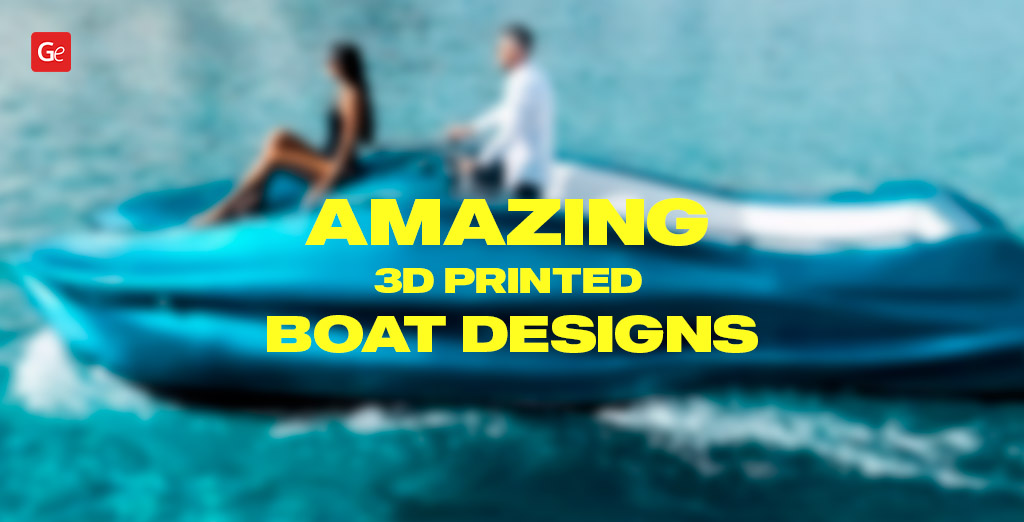
Read also: 15 Most Impressive 3D Printed Ships
3D Printed Boat
Thanks to additive manufacturing , different industries develop way quicker than they used to years ago. 3D printing is used in medicine, automotive business, space, air, everyday life, and also maritime services. Thus, it is not surprising to see more and more boat parts 3D printed.
Thanks to a significant number of 3D boat model STL files, anyone can 3D print boat accessories, sterns, bows, hull parts, and other important components using different scales. So take some time to enjoy photos of small and giant 3D printed boats (fully or partially) and you might need one of the large 3D printers to build one for yourself.
1. Boat 3D Print: Largest Ever
A 3D printing boat can be as giant as you want it to be. The University of Maine currently holds the world record for building the biggest solid 3D printed boat in the world.
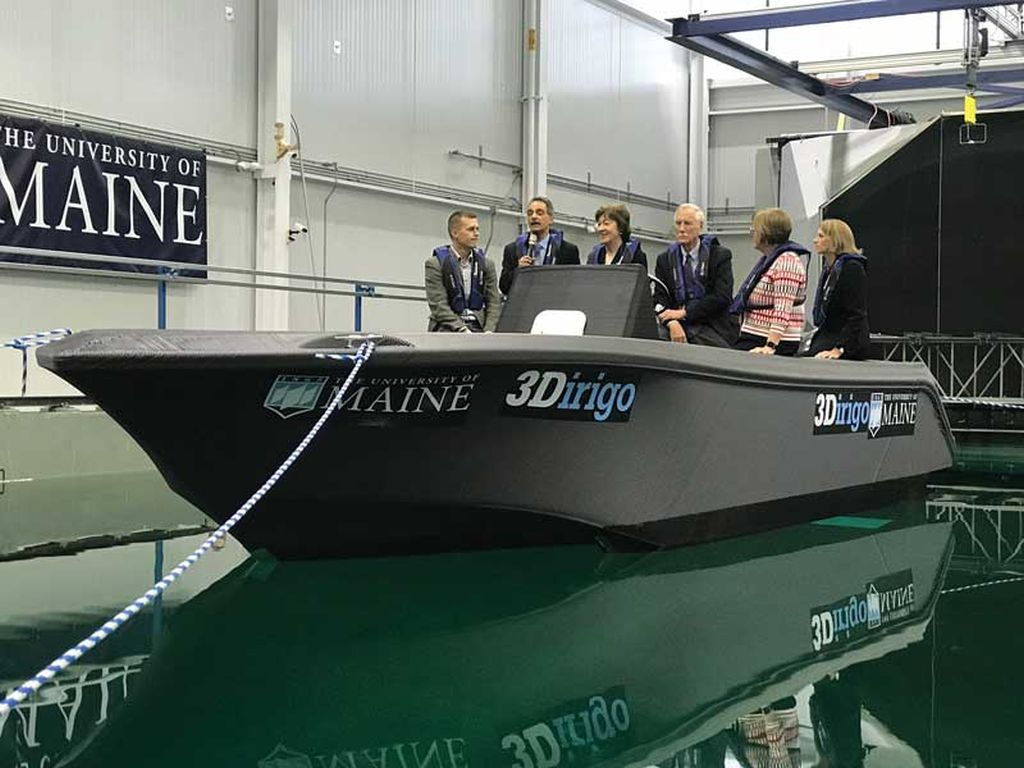
To make this project real, the University used the biggest prototype polymer 3D printer in the world. It is now the biggest solid 3D print in history, and it took only three days to construct this impressive vessel.
What makes the largest 3D printed boat a miracle is that she truly floats! Her size is 25 feet (7.6 meters) long and her weight is 5,000 pounds (2,268 kg).
While this boat 3D model is not available to the public, the University tested its seaworthiness and assured the vessel boasted a multidirectional wave basin.
The boat 3D print even goes by its name of 3Dirigo. While it’s not the largest thing a 3D printer can build, it is the biggest solid vessel ever created through additive manufacturing.
Read also: Best 3D Printed Cars to Wow Everyone
2. 3D Printed Sailboat
It is now possible to 3D print sailboat projects to prevent some of the dangerous plastic waste. It can be a win-win idea for businesses and organizations that save the oceans from tons of plastic waste that gets into the waters every minute.
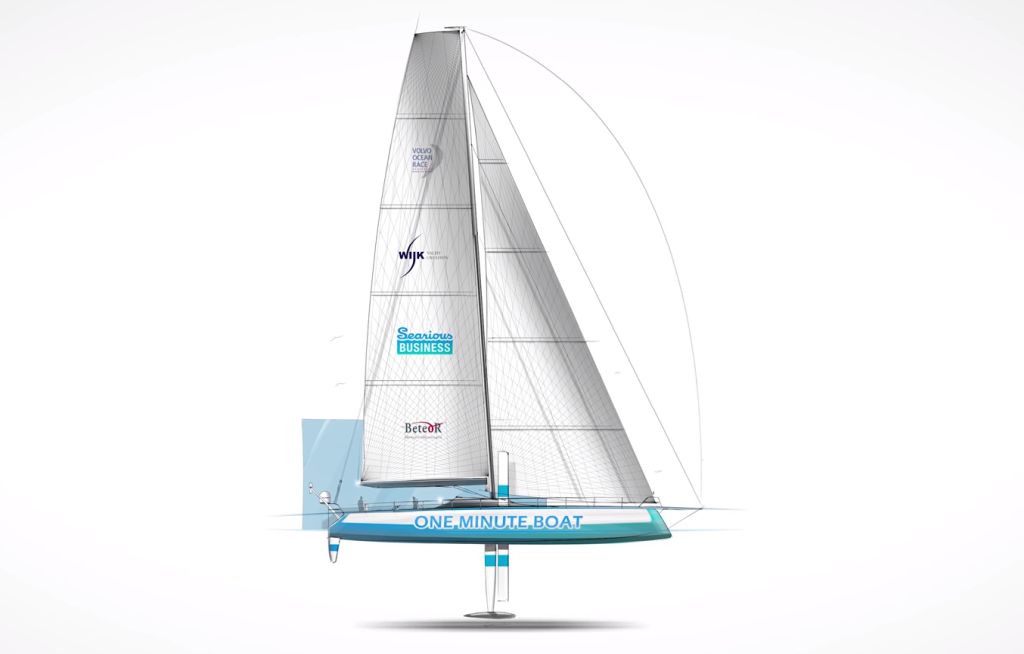
A firm Searious Business hopes to make a unique 3D printed boat as a part of its big fight against polluting the waters with plastic bottles. The company will 3D print a sailboat out of 44,092 pounds (20,000 kg) of PET plastic obtained from the used plastic bottles. Another firm Lay3rs will help to bring this project to life through its 3D printers.
The more 3D printed sailboat objects are created, the less ocean pollution would exist.
3. 3D Printed Kayak
The imagination lets you use your 3D printer to create all kinds of stuff , including a 3D printed kayak. Jim Smith from Grass Roots Engineering worked hard to create a real functioning 5-meter-long (16.4 feet) kayak of ABS plastics.
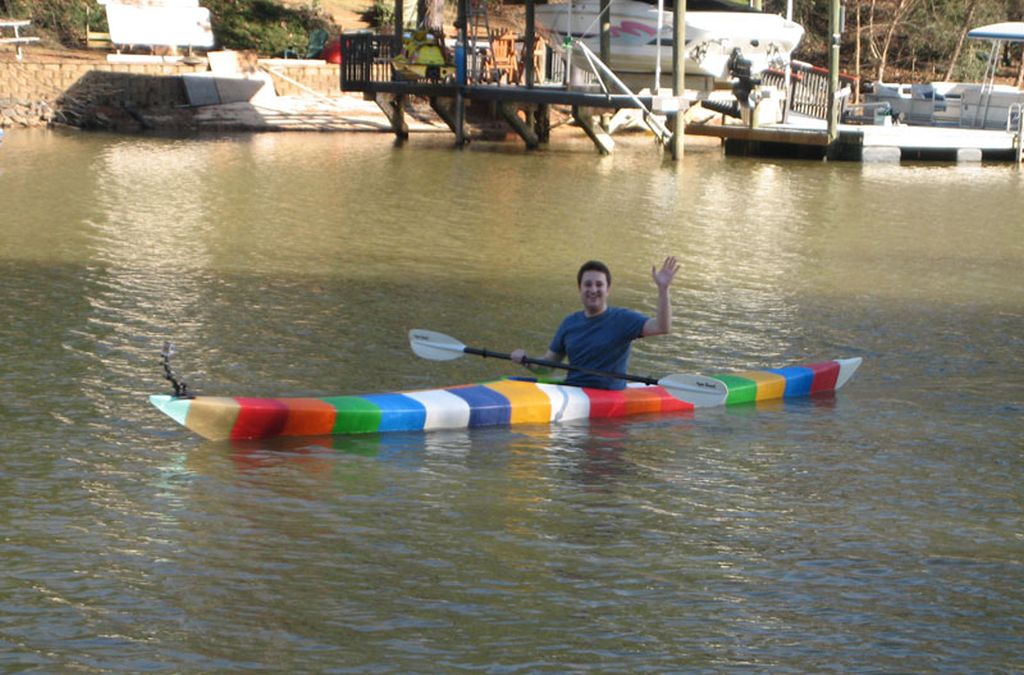
This model is more than just a prototype. Its weight is slightly over 66 pounds (30 kg). It is a life-size 3D print that only required some screws to assemble and extra accessories (silicone adhesive and threaded inserts).
To 3D print his dream boat, Smith even built a large custom 3D printer.
4. 3D Print Boat that Functions
Some years ago Italians saw a real 3D printing boat sailing through local waters. The size of that cutie was slightly over 21 feet (6.5 meters) x 8 feet (2.5 meters). And she weighed 1,765 pounds (800 kg).
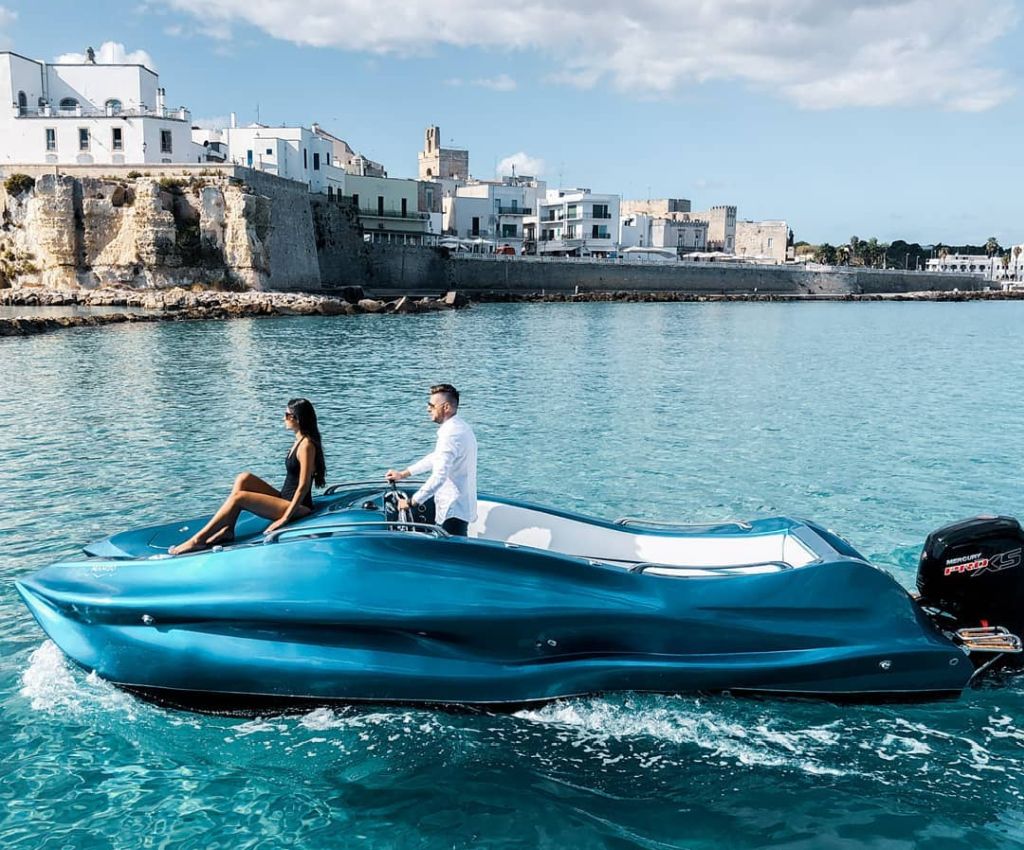
That functioning boat print was made by several companies, including Moi Composites, Autodesk, and others. She presented herself well during the Genoa boat show back in 2019.
Known as MAMBO, this 3D printed boat became the world’s first vessel made of fiberglass with the use of 3D printers. While the company doesn’t publicly share the 3D printed boat cost, you can visit their official website and find contacts to get more information about this unique project.
5. 3D Printed Boat Hull
A 3D printer can help you build any giant vessel you wish, including a yacht. Thermwood company has proved this with its innovative project when it 3D printed boat hull sections from a 51-feet-long (6.4 meters) yacht.
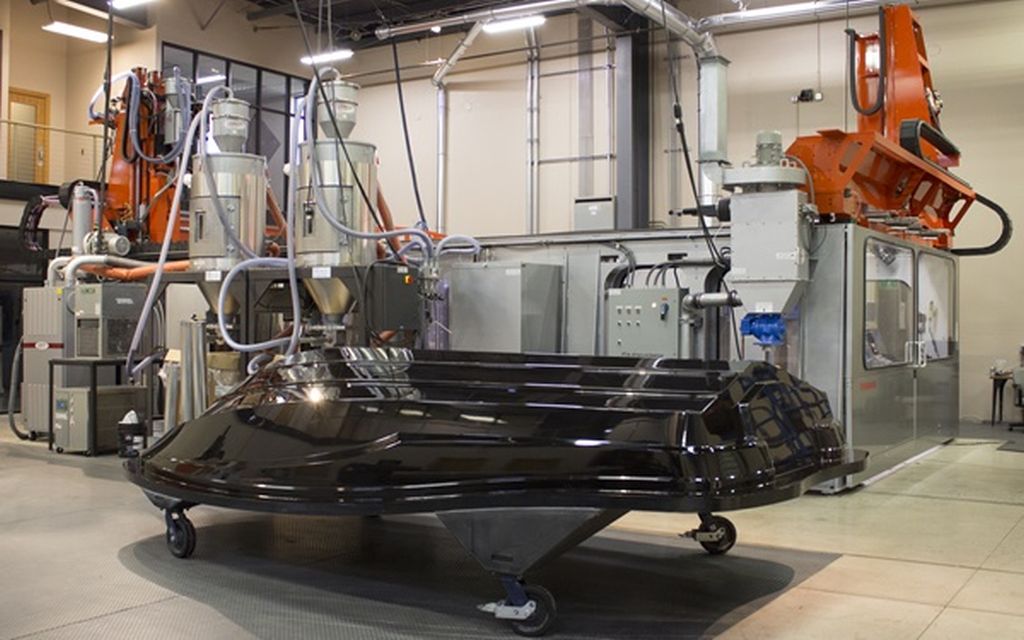
The firm chose carbon fiber reinforced ABS for this project. It assures that such material is a low-cost solution if comparing it to other high-quality thermoplastics.
The 3D printed boat hulls can change the future of how vessels are made and low down the costs of producing yachts and other big ships.
Read also: Incredible Stuff You Can Make with a 3D Printer
6. 3D Printer Boat Model
Some firms begin to take full advantage of additive manufacturing when building their projects. Tanaruz, a 3D printed boat manufacturer, has big plans to increase its production of vessels to 300 a year by 2023.
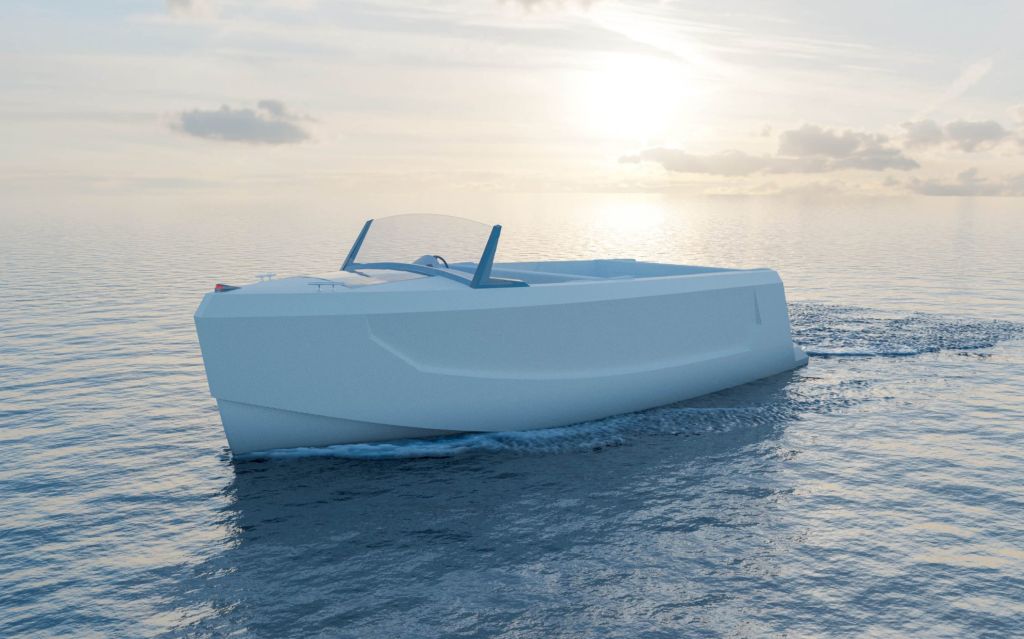
The company relies on reusable polymers to make boat 3D print production more affordable to customers. When such a vessel ends its life, it is possible to shred it down and reuse it to 3D print a new boat.
Their 3D printer produced by ABB company has a length of about 46 feet (14 meters). And the production itself leads to no waste! Such an eco-friendly solution can help to make all 3D boat designs easily accessible and buildable. Besides, you can always use renewable energy to get lights on your vessel and think of friendly materials to recreate its interior. This would however add to the basic 3D printed boat cost that starts at $15,785 (€15,000).
7. Boat 3D Model (Seaworthy)
Modern companies know how to 3D print boat projects that are seaworthy. Two firms, Research Institute of Sweden and Cipax, collaborated to work on the first-ever European one-piece seaworthy 3D printed boat.
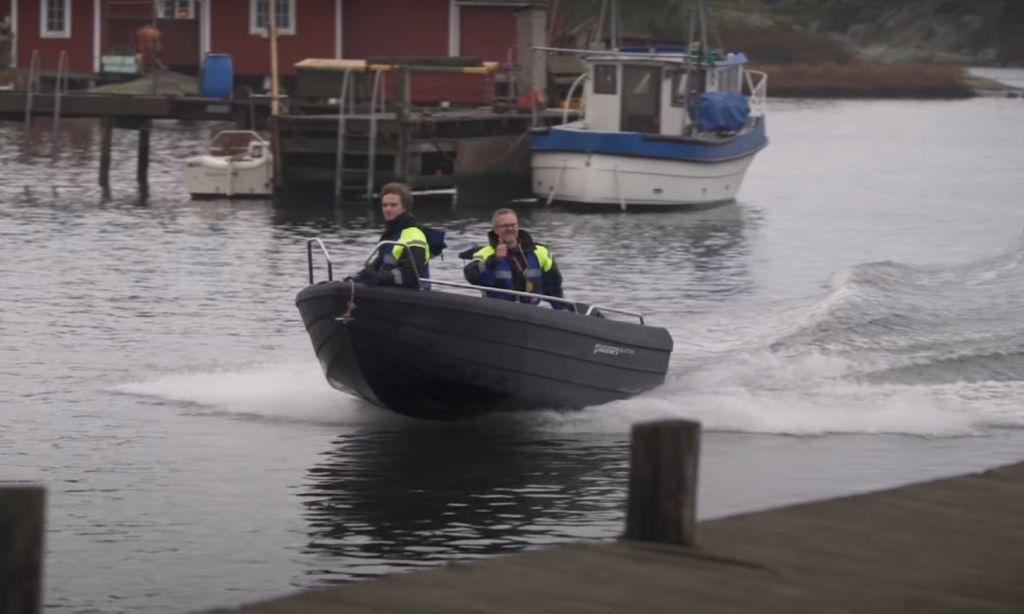
Such a unique 3D print was built from glass fiber and plastic with the help of ABB robotic arms. The model was named Pioner 14 Active Dark Line.
And once the companies figure out the way to balance the extra material density with the boat hulls, it could become a great commercial boat 3D model for different customers who wish to sail in a 3D printed object.
Read also: Is It Safe to Leave a 3D Printer on Overnight?
8. 3D Printing Boat (Autonomous)
Institutes and laboratories collaborate to create an exclusive 3D printed boat model that would be fully autonomous. Such vessels could change the future of the maritime sector.
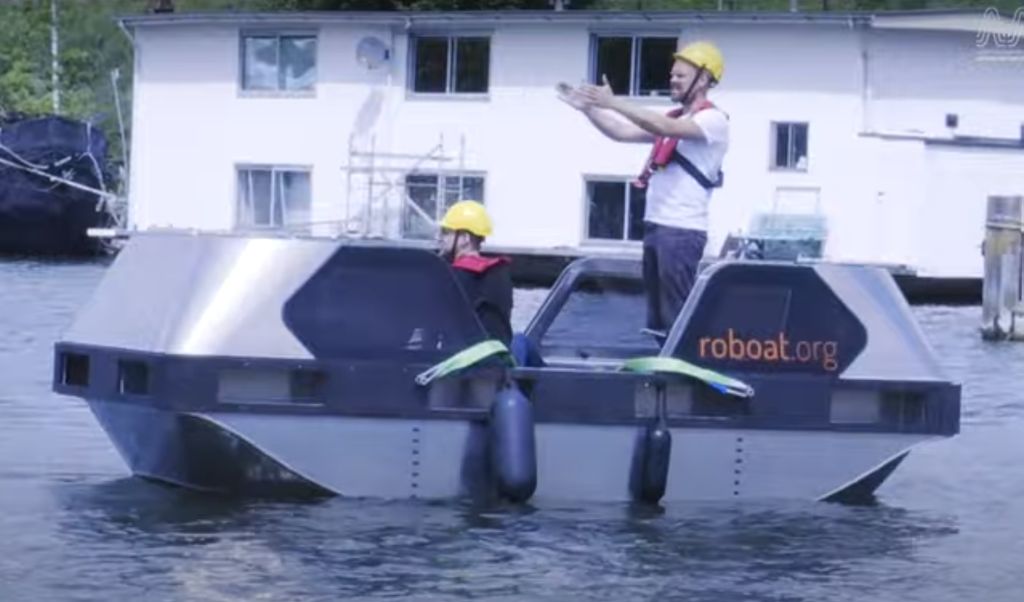
Once the self-driving technologies are added to the 3D printed hulls, it may be possible to build floating boats and make as many fleets as needed.
Such autonomous vessels can help to perform many valuable duties, such as good delivery, waste collection, transportation, etc.
9. 3D Printed Boat Toy
Enthusiasts who just got their first 3D printer or wish to make a 3D printed boat toy for their kids can find many great models online. Gambody marketplace, for example, offers Patrol Boat 31 Mk 2 3D Printing Model STL files you can download and print.
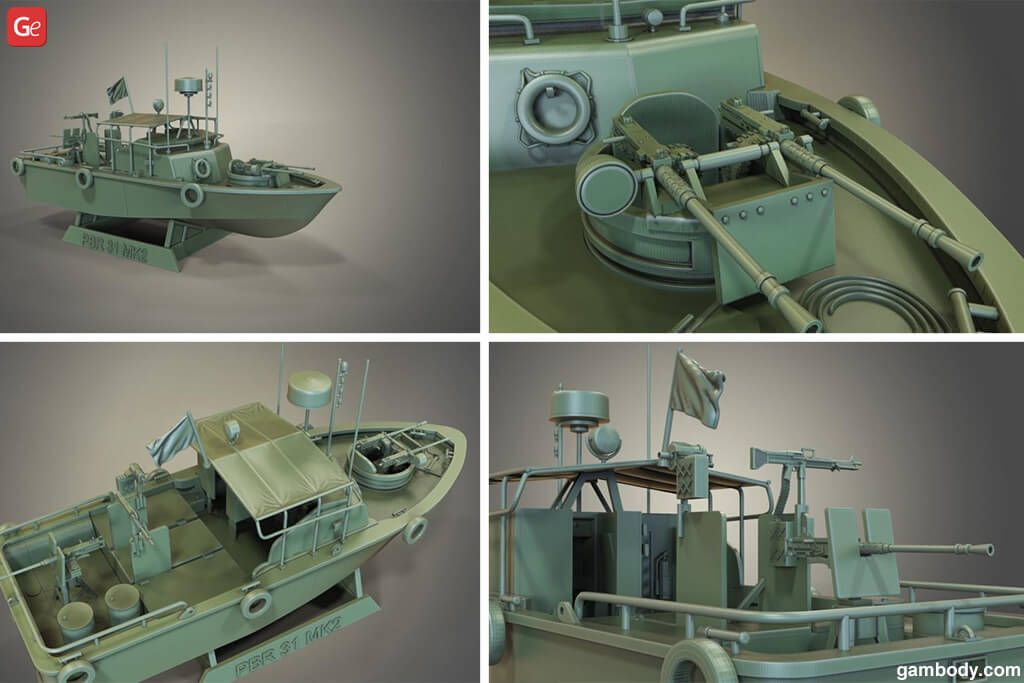
Such US “Brown Water” Navy patrol boats were common during the Vietnam War from 1966 to 1971. You can make this piece to add to your collection or let your little ones play with this 3D printed boat toy!
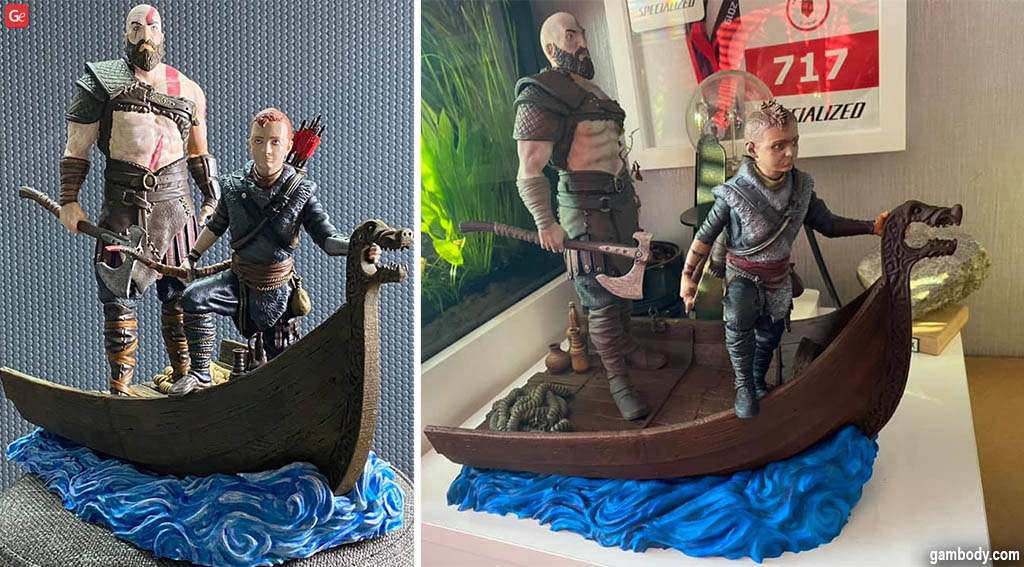
If you are a fan of medieval 3D printed boat designs, you can recreate the God of War diorama using your 3D printer and “Old Kratos and Atreus” STL files . The half of an old-style boat you can assemble features a dragon stern and waves.
If you don’t feel ready to 3D print boat designs using complex highly-detailed STL files , you can always begin with making a benchy 3D printed boat. This famous testing object is available to all hobbyists for free.
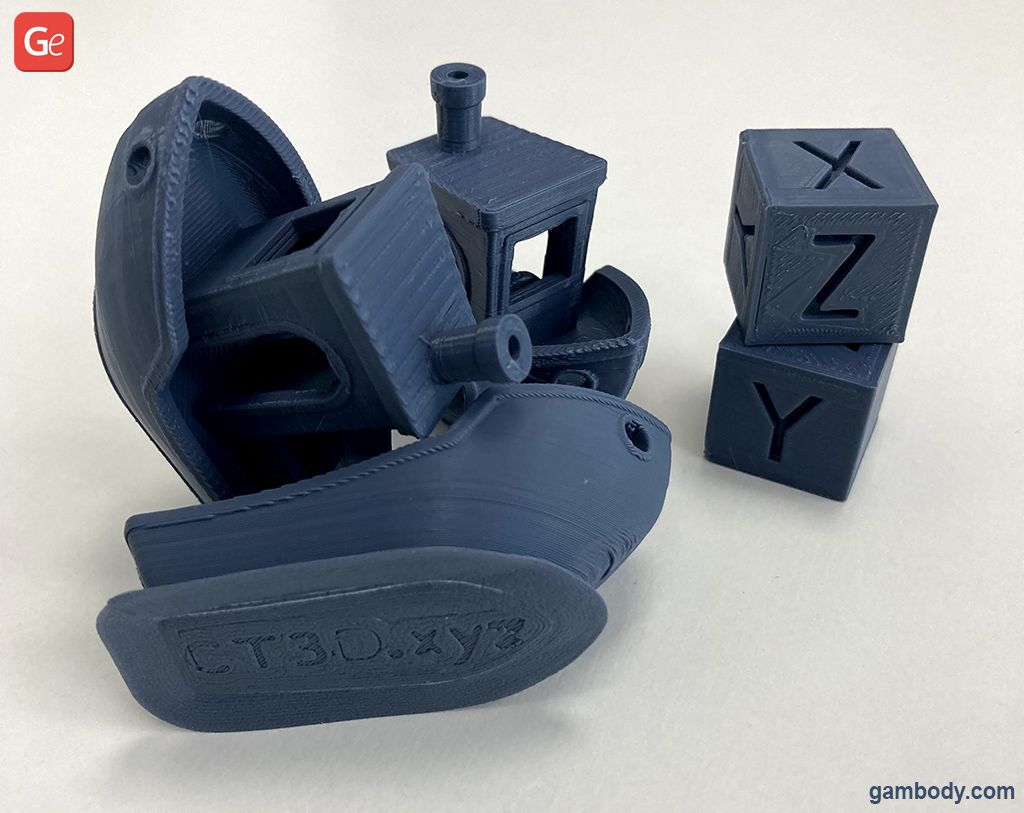
10. 3D Printed Yacht
Companies do their best to introduce 3D printed yacht projects to customers all over the world. Some firms in New Zealand, Italia, and other countries work hard to produce boat parts and accessories via additive manufacturing.
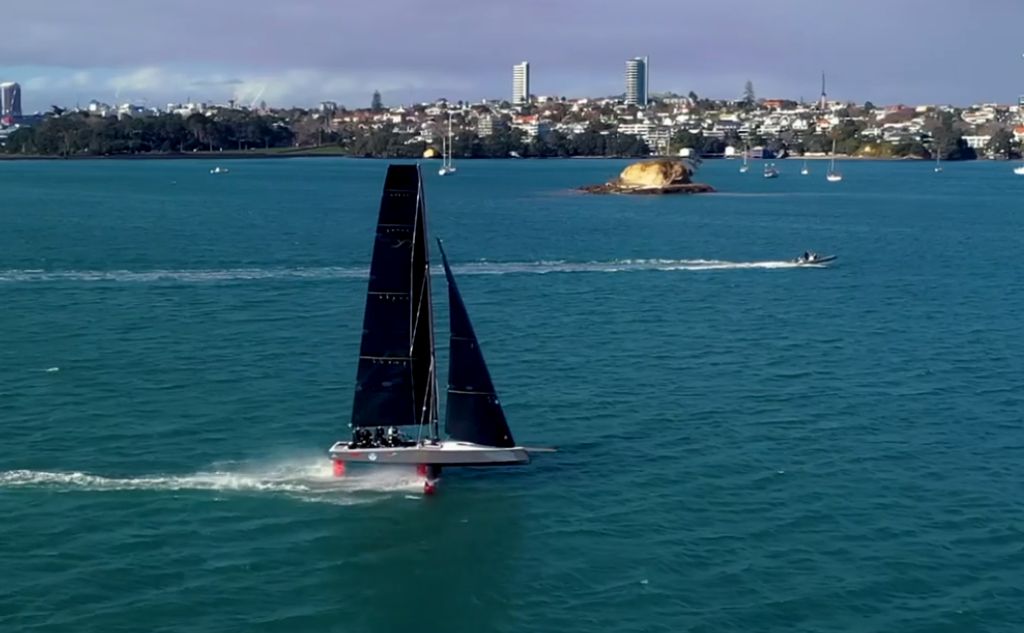
The world would most likely soon see many 3D printed yacht models thanks to innovative firms that take full advantage of additive manufacturing today. We have already seen some 3D printing fishing boats and small sailboat AC9F to take part in America’s Cup.
What will come next?
If your 3D printer is not big enough to recreate a life-size 3D printed boat, you can always make a toy or test the simple benchy model. Make sure to join Gambody 3D Printing Community on Facebook to share photos of your new 3D prints. Hobbyists worldwide cannot wait to adore your next projects!
- Share Article:
The Best 3D Printer for Beginners: 15 Entry-Level Machines

Game of Thrones 3D Print Ideas: Miniatures, Figures, Dragon Models
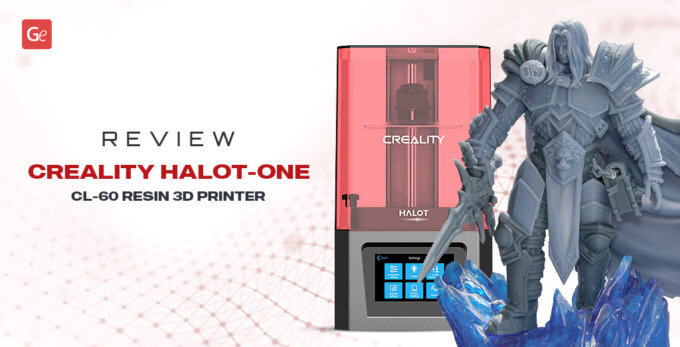
Creality Halot-One CL-60 Resin 3D Printer Unboxing and Review

Professional BoatBuilder Magazine
Print yourself a boat.
By Dieter Loibner , Sep 10, 2018
A 3D-printed construction mold has potentially big implications for the boatbuilding industry, but the road won’t end there. The next step is taking this technology from tooling and prototyping to production of almost anything—human joints and organs, bicycles, cars, airplanes, surfboards, hardware, and, yes, entire boats. Forget Hanseyacht’s tongue-in-cheek press release from 2016 announcing it had printed a yacht from wood. If all goes according to plan, by the time you read this issue of Professional BoatBuilder, Livrea Yacht in Palermo, Italy, will be putting the finishing touches on a 3D-printed racing yacht , a Mini 650 intended to compete in the 2019 Mini-Transat Race. Yes, in this project they’re printing the actual boat, not just a construction mold, which is described in detail in the cover story of PBB 175, Just Print It!
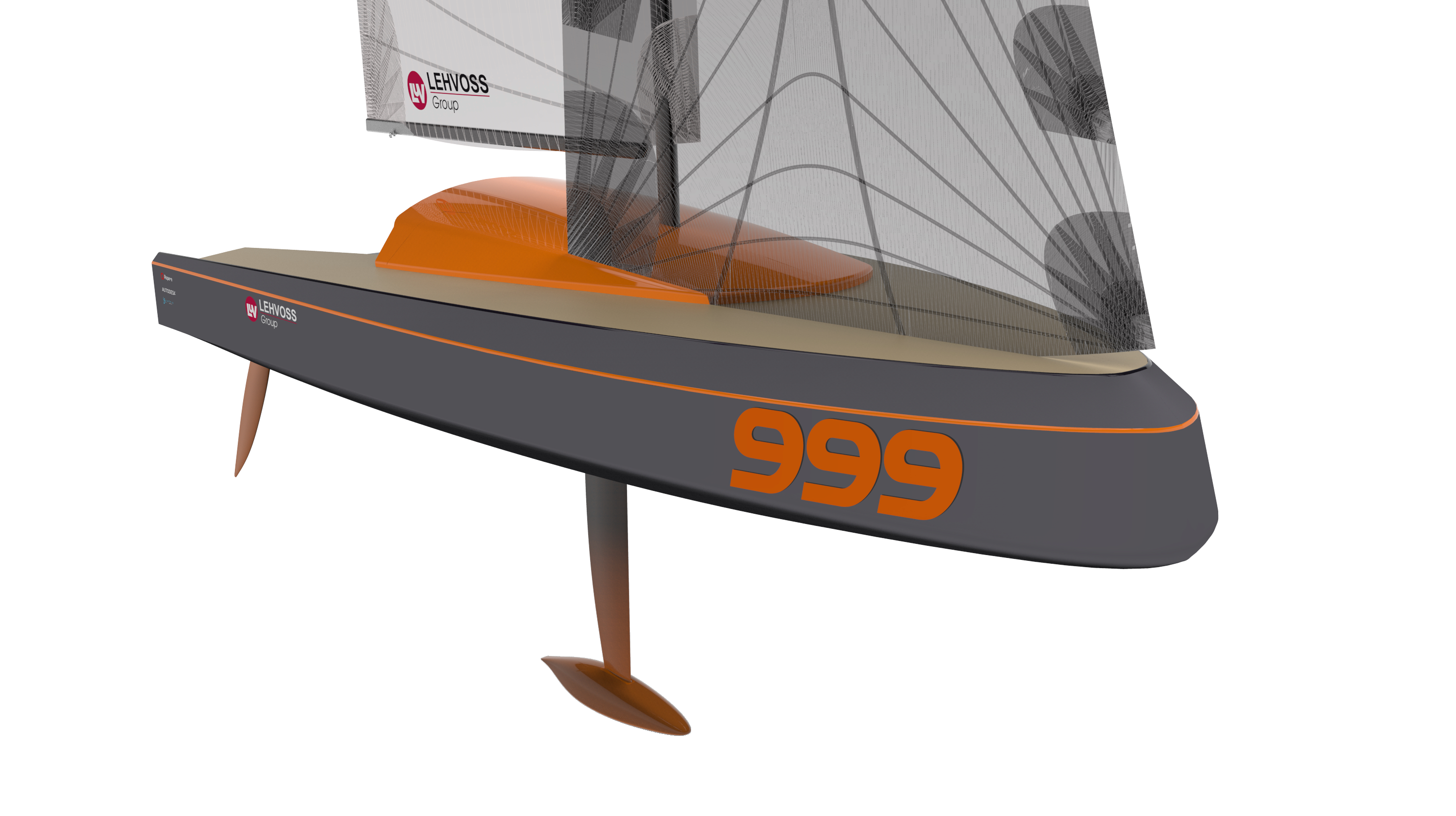
A rough rendering of what the 3D-printed Mini 650 might look like
Supported by the Lehvoss Group and Autodesk , Francesco Belvisi and Daniele Cevola, the principals of Livrea Yacht, who also founded the 3D-printing outfit Ocore , have been working on this radical approach to boatbuilding. They won Italy’s 2017 National Innovation Award for a new (and patented) material-deposition strategy that uses advanced polymers with carbon fiber reinforcements and an algorithm inspired by fractals , which the mathematician Benoit Mandelbrot called “beautiful, damn hard, [and] increasingly useful.” Mandelbrot expanded the concept of theoretical fractional dimensions to geometric patterns in nature.
Isogrids for more stiffness and strength
Taking a page from aerospace construction, Belvisi and Cevola used isogrids to add torsional stiffness and resistance to bending and buckling in the hull shell. An isogrid is a partially hollowed-out structure with integrated triangular stiffening ribs.
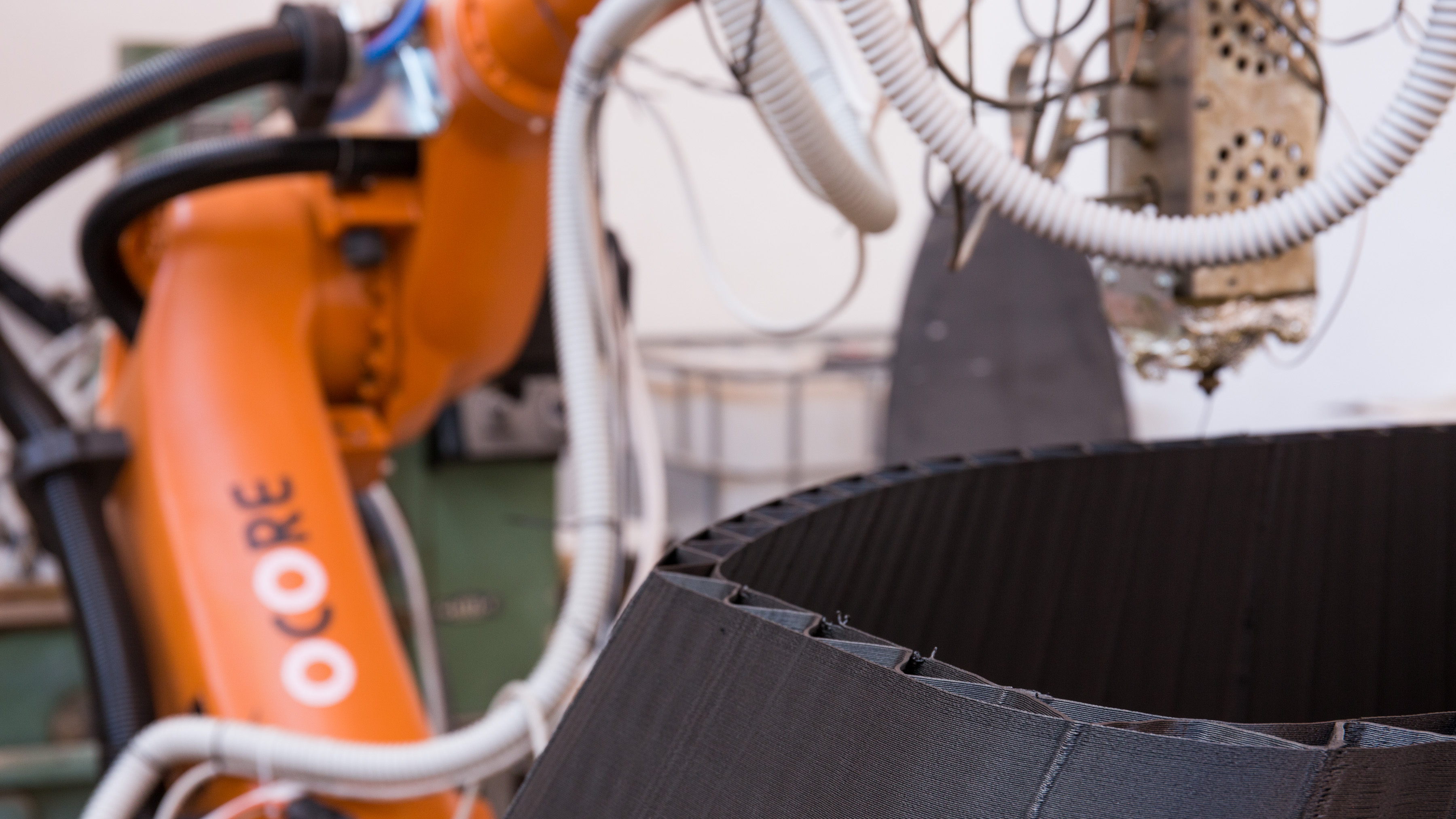
A closer look at the isogrid structure of a 3D-printed hull-part for Livrea Yacht’s Mini 650
It’s super light and super stiff, but complex and expensive to manufacture. If the Italians can successfully reproduce it with a specially programmed 3D printer, that might change. To achieve this robotic dexterity, they turned to Alessandro Buscemi, a numerical modeling expert, who helped them write software code in the Kuka Robot Language (KRL) , which was necessary to generate what they described as “smoother movement of the [print] robot.” That was key to developing a new printing technique that departs from the sliced mesh and polygonal geometry of traditional 3D-print jobs in favor of Bezier surfaces .
Exciting as all this might be, it takes more to make a boat. Cevola: “The isogrid structures will be joined with the carbon skins, biaxial 300 gr (8.8 oz) and uni-directional 150 gr [4.4 oz], with a vacuum-infusion system, because we don’t have an autoclave that’s large enough for the boat. Smaller parts will be joined in an autoclave, however.”
Carbon in the 3D-print feedstock and in the skins
Also important is the reinforcement of high-load areas such as the keel box, the shroud, and the rudder attachments, which Cevola said he plans to address with “monolithic stratifications to dissipate concentrated loads.” The boat’s target weight is 930 kg (2,050 lbs) all up, which is heavier than conventionally built boats like Eight Cube , a foiling Mini 650 launched for the last edition of the Mini-Transat with a displacement of 750 kg (1,653 lbs). But Cevola isn’t deterred. “Since the boat will be involved in a transoceanic regatta, we did not want to introduce too many variables to the project. We will have a similar weight but certainly great advantages in terms of process and efficiency of the structures. We expect to be lighter in the future.”
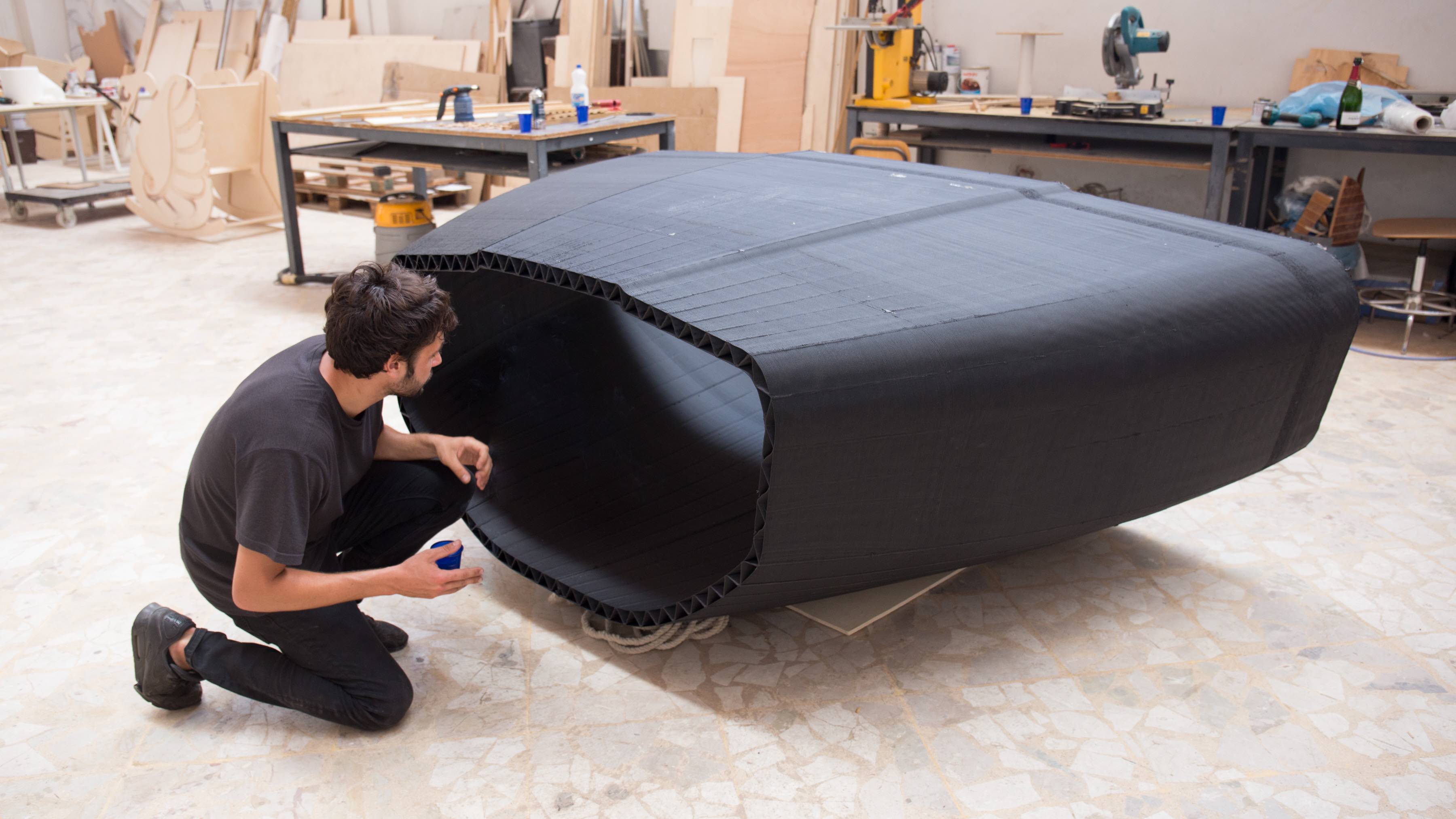
A worker inspects the 3D-printed bow section of the Mini 650.
The success of this approach also depends on the suitability of the printer’s feedstock—a polyamide with 25%–30% of carbon reinforcement called PA12, developed by the Lehvoss Group. Lehvoss also markets PEEK, a “semi-crystalline thermoplastic [that] combines excellent mechanical characteristics with excellent chemical resistance,” according to Cevola. He points out that it can be used in temperatures ranging from 60°C (76°F) to 260°C (500°F) in hot water or steam.
He says that Livrea Yacht worked with Eurisco Consulting on computational fluid dynamics and velocity prediction to ensure that the boat will be optimized for competition. Livrea is also conducting materials testing with an eye toward certification. The launch of this yet-to-be-named boat is scheduled for September 2018, with sea trials in October.

Daniele Cevola, one of the project’s leaders
Other highlights of the project include:
- The structure is printed in four parts that will be joined with a structural adhesive.
- Mast and boom will be built from prepreg carbon and cured in an autoclave.
- The rudder will be 3D-printed with a hollow structural core and sheathed with woven and unidirectional carbon fiber.
For more on the advances in 3D printing in boat building and design, read Just Print It! , the cover story of PBB175 and Printing Small Parts that explains how this technology is used for modeling and rapid prototyping.
Read more Construction articles

- Gunderson Marine Pays Welding Students
Gunderson Marine of Portland, Oregon, recently side-launched Makani Loa, a 438‘ x 105‘ (133.5m x 32m) container barge for Lynden/Alaska Marine Lines from its 58-acre (32.5-hectare) manufacturing site in the industrial area north… Read more »

- Noise Reduction with QuietRide Sound Shield
From Ray Hunt Design comes a timely answer to the growing menace of outboard motor noise.

Stitch-and-Glue Canoe
As renowned wooden boat designer and builder Sam Devlin transitions into the calmer waters of his career, he’s handing the reins of Devlin Designing Boatbuilders to his son McKenzie and… Read more »

Recent Posts
- AkzoNobel’s Awlgrip brand launches revolutionary 3D Color Visualizer for boaters and professionals
- CTM Marine Prepares for Summer 2024
- Crushing the Marine Canvas Crunch
- Companies (89)
- Construction (111)
- Design (165)
- Drawing Board (11)
- Education (27)
- Environment (16)
- Events (22)
- Materials (52)
- Obituary (18)
- People/Profiles (49)
- Products (17)
- Propulsion Systems (33)
- Racing (17)
- Repair (37)
- Rovings (322)
- Short Cuts (3)
- Sponsored Partner News (18)
- Systems (80)
- Task Sheet (1)
- Uncategorized (27)
- Wood to Glass (7)
ProBoat.com Archives

3D Printed Superyacht Concept Unveiled
February 3, 2023
Designer Jozeph Forakis has recently unveiled the world’s first 3D printed superyacht, the 88-metre Pegasus concept. The yacht is designed to be sustainable and virtually invisible” thanks to mirrored facades that reflect the ocean and sky, mounted to the exterior of the yacht.
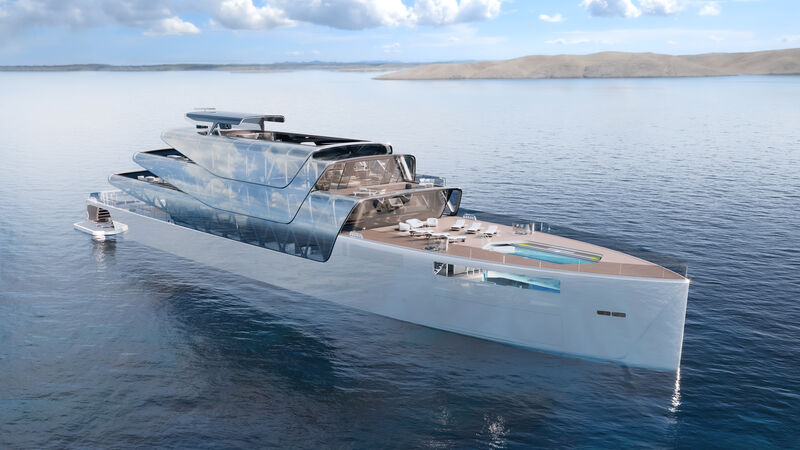
The construction of Pegasus will use robotic 3D printing to create a mesh framework, which will be more energy, waste, space and material efficient compared to conventional construction. Jozeph Forakis is known for his innovative designs and is considered a disruptive force in the superyacht industry.
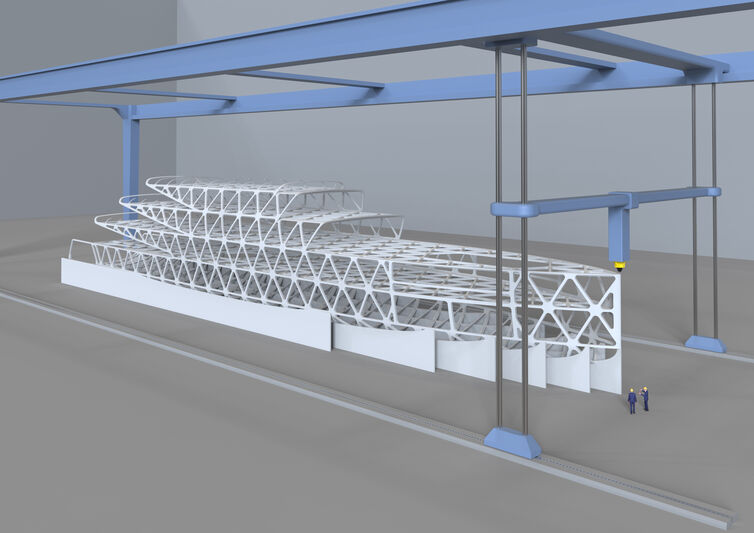
The yacht runs on solar energy, converting seawater into hydrogen, producing zero emissions and offering an infinite range.
The interior spaces of Pegasus offer a minimalist design combined with living nature, including a hydroponic garden, wellness zen garden and reflective pool. The yacht will feature a hydroponic “tree of life” that will pass through multiple decks, providing food for passengers.
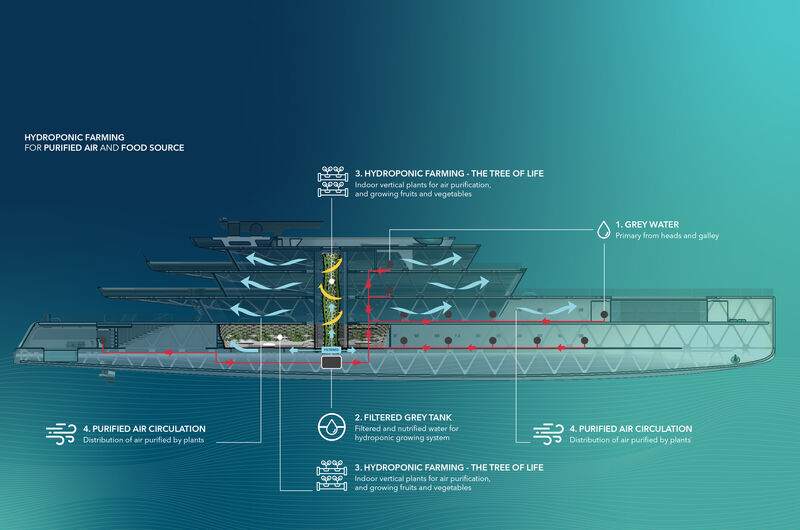
The top level is exclusive to the owner with a forward-facing primary suite and various luxurious amenities.
While Forakis has a background in biomedical research, his work as a designer has seen him working in marine architecture before, as he previously designed the CLX96 SAV – Sea Activity Vessel, which was first shown at the Fort Lauderdale International Boat Show.
What do you think of the 3D printed superyacht?
Is additive manufacturing the future of shipbuilding?
Come and let us know your thoughts on our Facebook , Twitter , and LinkedIn pages, and don’t forget to sign up for our weekly additive manufacturing newsletter to get all the latest stories delivered right to your inbox.
Our newsletter is free & you can unsubscribe any time.
Maker Builds 3D Printed Bottle Labeling Machine
A maker named “Fraens” has created a detailed bottle labeling machine primarily constructed from orange 3D printed plastic. The machine highlights the use... read more »

Researchers 3D Print Ultra-Strong Deformable Aluminum Alloy
High-strength aluminum alloys are prone to hot cracking during additive manufacturing, limiting their applications. Researchers in the US have been exploring the use... read more »

SiNAPTIC Technologies Receives State Grant for Ceramic Additive Manufacturing
SiNAPTIC Technologies has received a grant from the Colorado Office of Economic Development and International Trade (OEDIT) Advanced Industries Accelerator program. The grant... read more »

3D Printed Gallium–Carbon Composites Developed for Wearables
Researchers in Portugal are using Gallium–carbon composites for 3D printing sensor-heater-battery systems in wearable electronics. These applications require flexible, durable materials that maintain... read more »
Eminent Spine’s 3D Printed SI Screw System Gains FDA Approval
Eminent Spine has received FDA 510(k) clearance for its additively manufactured and machined titanium SI Screw System. This system will be presented at... read more »

Beehives 3D Printed for Sustainable Farming in Mexico
José Francisco Arteaga Alarcón has developed 3D printed beehives to support sustainable farming. Alarcón, a student at Chapingo Autonomous University, Mexico, used resin... read more »

Utah Students Win Heat Sink Challenge
A team of undergraduate students from the University of Utah has won the ASME/K-16 and IEEE/EPS Student Design Challenge for the second consecutive... read more »

3D Printed Traps Aid in Tracking Invasive Species in Ontario
A pilot project has employed 3D printed traps to monitor the spread of the hemlock woolly adelgid (HWA) in Ontario. HWA, a small... read more »

SLS4All 3D Printer Now Available
The SLS4All Inova 3D printer project has reached completion, with version one now available for shipping. The DIY SLS kit is priced at... read more »

United Utilities Launches 3D Concrete Printing Hub for Water Assets
United Utilities, in collaboration with ChangeMaker 3D, Manchester Metropolitan University, and Scottish Water, has established a 3D concrete printing hub in Wigan. This... read more »

How to 3D print a boat
Published by owen on march 13, 2022 march 13, 2022.
If you’ve read my previous posts, you’ll know that I’ve already built the full size boat , so why am I 3D printing a smaller one? Well my initial test boat was a very simple wooden build but it wasn’t very robust. I’m sure you can look at the picture and guess why (the propeller didn’t sit in the water and the water almost came over the sides)!

I needed a way to test the electronics, motors and algorithms and with the full size boat being so large it makes testing very difficult. Therefore I decided to 3D print a new test boat but instead used a new design so that I could make some improvements to the stability. Considering it’s a test boat, it’s going to need to be as stable as possible.

Whilst doing all of this there’s a crucial lesson that I learnt, it’s that I should have built a small prototype, tested that and got it working fully, and then built the full sized version. But hey that’s hindsight for you, and at least now I’ll have a smaller robust boat I can use for testing.
So let’s talk about the design. The full size boat has a narrow hull that was designed for efficiency but it doesn’t make it very stable and the bow sits in the water a bit too low. Therefore this boat has a much flatter hull to provide stability for testing. It’s a fairly large model, and at a meter long this allows me to add extra components such as cameras and mounts so that I can test new hardware and develop new features.

Alongside the inner hull there’s a lip with screw holes so I can slot and add extra components. The back of the boat has a raised platform which will allow for mounting of the servos and the motor pod steering mechanism. This platform also has many holes which can be used to secure different components. The idea is the design should be as flexible as possible to account for future alterations without having to do large re-prints.

The motor pods and their mounts have been designed in the same way as they will be installed on the full size boat. This is so we can test the mechanisms in the smaller boat before drilling holes and installing them on the full size one.

The motor pod consists of a pod that will be submersed under water with a propeller and motor. It attaches to the boat by a stainless steel pipe that will rotate in order to change the direction of propulsion. More about the motor pod design will be discussed in a later article. To allow the steel pipe to rotate and no water to pass through the mechanism contains a bearing and a seal.

The lip on the top of the boat has screw holes in it that allows us to attach a lid (or in boat terms, a deck)! The deck was quickly designed so it won’t create a waterproof barrier but it does give us a decent level of protection from splashing.

The electronics used in the first test boat has been mounted on a removable board. Therefore the 3D printed boat has been designed to be wide enough for this to be installed. This means I can easily move the electronics between both boats for testing.
3D Printing

Due to 3D printing size limitations the boat has to be printed out in 10 parts. We’ve designed these sections to be bolted together and o-rings will be used to create a seal between the parts. Bolts will be used to hold them together instead of glue as this means we can always reprint or modify certain sections of the boat.

As the parts were 3D printed in large sections you have to design them to be printed in this way. For example, you can only print overhangs of about 55 degrees reliably. Otherwise you’re printing the plastic in to thin air! If there’s only one overhang we try to design the object so it’s printed with something underneath to support it (but without using supports as that wastes a lot of material). If we can’t design something to support it we just design the overhang at no more than 55 degrees or rethink the design.
Waterproofing
As 3D prints aren’t naturally waterproof we will need to waterproof them. You can print with more walls of plastic, use higher layers or extrude slightly more plastic, and those do help to reduce the permeability of the print. However that would use a lot more plastic, especially for a very large print like our boat. Instead we sealed the outside of the print using some clear coat spray. I did attempt this with lacquer but I prefer the clear coat spray as it contains acetone, so it actually melts the plastic together to create a barrier.
Tip: don’t spray too much otherwise you will get drips!
3d printing in practice.
The parts took over a month to print. As they were pretty large each one took over 24 hours. However the most challenging aspect was the parts warping and all the attempts trying to fix this is what made it take so long.
ASA/ABS are known for shrinking a lot more than PLA, and large prints are often prone to warping. As the print cools over large periods of time this causes the print to warp and pull away from the bed. This also causes cracking, which is obviously pretty bad for our prints.

Due to warping some of the parts aren’t perfect which has meant that there are either some cracks in the parts or gaps between them when bolted together. O-rings have been used to create a waterproof seal but they weren’t designed to bridge large gaps. So to fix this I’ve put silicone sealant along all the edges and then bolted the parts together.
To prevent this you first need to ensure that you have good adhesion between the bed and the print. To do this I:
- Clean the bed with acetone between prints, and don’t accidentally touch it with any fingers. I’m using the steel sheet from Prusa, so I don’t use anything else such as tape or an acetone blob on the surface, as the prints are generally rock solid to remove, even if they’ve warped.
- I extrude wider lines for the first layer, so the plastic has more contact with the surface.
- Then as warping is caused by the cooling of the print, I keep the enclosure as hot as possible. I found that when I sealed up the gaps in my enclosure this made a notable differences in the warping.
Printing out good parts became one of the hardest challenges, but as it’s only a test boat it doesn’t have to perfect. Stay tuned for more articles on how the motor pod was designed and tested and hopefully some demos of it in the water!
Leave a Reply Cancel reply

Your email address will not be published. Required fields are marked *
Save my name, email, and website in this browser for the next time I comment.
Related Posts

Boat Design
Building a fibreglass hull – part 1.
This will be part 1 of a 3 part series which talks about the process of designing and building a fiberglass boat. The electronics and a basic system was tested on a small prototype boat Read more…
Stay tuned for the latest updates and details of the build progress and launch event. Follow us on Twitter.
3D Printing Metal: How Does It Work?
These high-precision printers melt metallic powders into functional prototypes and ready-for-use parts.
3D printing has made it easy to quickly create everyday items out of plastic, houses out of concrete and even food out of edible filaments. But there’s a race within additive manufacturing to develop high-throughput printers that work with a different kind of material: metal.
What Is Metal 3D Printing?
Metal 3D printing is an additive manufacturing process that prints metal-based materials (such as aluminum, stainless steel, titanium, copper and nickel) to create three-dimensional structures.
Tech startups, researchers and manufacturers turn to metal 3D printing to print fully functional prototypes and custom, end-use parts on quick turnaround with total design freedom and high precision. Depending on the project, metal 3D printing may even serve as a low-cost alternative to traditional methods.
Metal 3D printing is an additive manufacturing process that creates physical objects from a digital model out of metal-based materials. As with any other material, metal prints are built one layer at a time using a variety of techniques that differ in the way they fuse metal feedstocks, often in the form of powder.
“Metal additive manufacturing requires higher power energy sources … and is much more industrial in nature than other forms,” Patrick Boyd, marketing director at EOS North America , told Built In.
As such, 3D printed metal is lightweight, durable and more flexible than traditionally manufactured metals (the strength and quality can match conventionally made parts).
Metal 3D printers enable in-house production of on-demand parts, which reduces supply-chain risk and quick replacement for high-wear applications.
“Humans have essentially been shaping, grinding, drilling and casting objects in the same manner for thousands of years,” Boyd said. And while traditional manufacturing methods aren’t about to be replaced by metal 3D printing, this technique “has removed many limitations of traditional manufacturing,” he added. And with limitless design freedom, “objects previously impossible to create from metal, whether one or many pieces joined together, are now possible.”
Related Reading What Is 3D-Printed Meat?
How Does 3D Printing Metal Work?
Metal 3D printing begins with a computer-aided design model. These digital mockups are spliced into cross sections, and feed the printer instructions on how to execute each layer.
From there, the actual build process initiates. Generally speaking, this starts with spreading a thin layer of metallic powder across a build platform. A high-energy source — laser, electron beam or ultrasounds — then selectively melts the powder according to the CAD-file blueprint, fusing the metal particles together.
These temperatures often exceed 1,000 degrees celsius and require heavily controlled environments, said Nasim Anjum, a mechanical engineer and PhD candidate researching composite materials at Binghamton University , State University of New York. In a vacuum chamber, for example, gasses like nitrogen or argon are used to prevent material oxidation.
After each new layer fuses to the previous one, the build tray lowers, and a fresh coat of powder is applied. This process repeats until the entire part is formed. Once complete, support structures are removed from the part, which typically undergoes additional post-production steps, like heat treatment or machining, to optimize desired properties, aesthetic and finish.
“Building parts layer by layer uses only the necessary amount of material,” added Anjum, who is conducting his research in Binghamton’s Nanomechanics Laboratory led by Professor Changhong Ke. When there is excess material, it’s often collected and recycled into the next project. This not only minimizes waste and reduces material costs, but also “promotes more sustainable manufacturing practices.”
Related Reading Stereolithography (SLA): What It Is, How It Works
How Is 3D-Printed Metal Used?
As a relatively new technology, metal 3D printing has been slowly making its impact on a number of industries. Every year, the variety of metals expands and novel approaches are expanded on or invented, “enabling designers to produce complex geometries and high-strength parts that traditional polymer 3D printing methods cannot achieve,” said Patrick Faulkner, a lead engineer at Accu .
The way metal 3D printing can handle high melting points with precision has changed the way designers look at producing prototypes and small runs of parts otherwise impossible to create with conventional, subtractive processes, Faulkner added. “This process results in [prints with] superior mechanical properties.”
Aside from speeding up the overall product-development cycle and fast-tracking the time-to-market, metal 3D printing enables companies to create tools and reproduce components in-house while significantly cutting waste.
Prototyping and Product Development
Engineers and designers use metal 3D printing to create both concept models and functional, high-fidelity prototypes. Rapid iteration allows a product’s form, fit and function to be tested at an accelerated pace, shortening the timeline to mass production. This enables rapid prototyping , shorter product life cycles and a quick time-to-market.
Manufacturing
Metal 3D printing is most often used to create high-precision prototypes and lightweight, custom parts for low-volume production runs. It can also produce molds for processes like injection molding and casting, and fabricate tailor-made jigs, fixtures, tooling and spare parts in house. In some cases, metal 3D printing beats traditional manufacturing methods in its ability to create semi-hollow parts with like-for-like strength-to-weight ratios in one go and complex, intricate shapes “that were previously impossible to produce,” Faulkner said.
Manufacturing lightweight, custom components that can withstand extreme environments is what lands 3D printing metal in the aerospace industry. Currently, engine parts, airframes, turbine blades, field nozzles as well as satellite launch vehicles in their entirety are being 3D printed by innovative startups inventing the tech as they go.
Developing metal 3D printers that can be used in outer space, “where traditional metal part manufacturing processes are more challenging,” is also in the works, Anjum said, noting the recent deployment of Airbus’ polymeric printers to the International Space Station.
While traditional manufacturing methods remain the standard, 3D printing metal is making waves in the automotive industry with prototyping and fabricating individual parts. It’s come a long way from car cosmetics, like gear sticks and decorative logos, to printing the entire chassis, suspension system and exhaust components of Czinger Vehicles’ 21c as well as BigRep’s fully 3D-printed, electric motorcycle, NERA .
Medical and Dental
In the medical field, metal 3D printing is used to create bio-compatible implants, prosthetics and dental crowns, bridges and implant bars with precise fit specific to the patient — even if that patient is a gorilla, like Gladys, who received the world’s first titanium, 3D-printed cast .
And while metal is a foreign material to the body, researchers are inventing ways to decrease the likelihood of rejection and infection, including antimicrobial 3D-printed metal for use in regenerative medicine as surgical scaffolding.
Metal 3D printing has found a way into nautical applications , primarily using titanium and stainless steel to produce boat propellers , hydraulic systems, rudders and foils as well as halyard trays, boat shafts, mounting flanges and custom hull components. In 2024, the United Kingdom’s Royal Navy acquired two 3D metal printers to handle repairs and print critical components that are no longer in production.
Related Reading 3D-Printed Organs: Are We Close?
Methods of 3D Printing Metal
Below are 3D printing techniques that are compatible with metal materials, beginning with the two most common categories — powder bed fusion and direct energy deposition.
Powder Bed Fusion
Powder bed fusion selectively fuses powder particles together using a heat source, such as a laser or electron beam. As a recoater blade spreads a thin layer of powder material across a build platform, the laser traces out a cross section, instantly melding the material together. This step is repeated layer by layer, with a fresh coat of powder until the model is built to completion. Known for its capability to fabricate complex geometries and intricate details with high precision, powder bed fusion is actively being used to produce lightweight aerospace components and biomedical implants .
Direct Energy Deposition
Direct energy deposition uses thermal energy — such as a laser, electron beam or plasma arc — to simultaneously melt and fuse metals as they’re extruded from a nozzle. A multi-axis robotic arm deposits molten metal feedstock (in the form of a powder or wire) at any angle, making direct energy deposition useful for performing repairs or adding material to existing components . This technique is often performed within a vacuum at reduced oxygen levels, and is especially useful for creating large-scale projects of near-net shape.
Material Extrusion
Material extrusion is typically reserved for thermoplastics and polymers, but can incorporate metals via filament mixtures of metal powder and a binder. Similar to DED, this technique uses a heated nozzle that directly extrudes spooled filament in a continuous stream onto a build tray. The robotic arm it’s attached to moves the printhead in a way that outlines each cross section of the print, as instructed by a CAD model. With metals, material extrusion is likely to require additional post-processing steps, like debinding and sintering.
Binder Jetting
Binder jetting adheres materials together by selectively depositing liquid binding agents onto a thin layer of powdered metal. This method, known for its high throughput and quick delivery, is unique in that it does not require a heat source. Instead, glue is dispensed from an oscillating printhead above a build tray that is lowered, then covered in a fresh layer of powder with each new cross section of the structure. Metal parts made from binder jetting typically undergo further production, such as curing and sintering, to optimize structural integrity and enhance built-in material properties.
Sheet Lamination
Sheet lamination joins metal sheets together using a variation of methods, from welding and heat to pressure, adhesives and even sound. A laser or blade cuts each layer to the desired shape, then fused or bonded to the previous layer until the design is complete. Excess material surrounding the print acts as structural support that’s removed during post-production and recycled for the next project. This process is relatively quick, cost effective and can be conducted at low temperatures. But these prints, which can also be made out of paper or plastic, are typically for aesthetic use only and not structurally sound or fully functional.
What Metals Can Be 3D Printed?
Some of the most common metals used in 3D printing are aluminum, stainless steel, titanium, copper and nickel-based alloys. Other popular choices include cobalt, tungsten and tool steels. These metals are processed in different forms as powder, wires, filament-mixtures and sheets.
Metals are matched to projects based on several conditions, from wear and corrosion resistance to strength and density. Depending on the intended use case, a metal’s electrical conductivity or thermal properties may be important to factor in, as well as biocompatibility.
3D printing precious metals — like gold, platinum, palladium and silver — is doable, but typically limited to jewelry- and watch-making, given their expensive price tags .
Frequently Asked Questions
Can you 3d print metal.
Yes; metal can be 3D printed using a variety of methods, the most prominent one being powder-bed fusion. The two most common techniques are selective laser melting (SLM) and electron beam melting (EBM).
How does 3D printing metal work?
Generally speaking, metal 3D printing works by spreading a thin layer of metallic powder across a build tray, which is then selectively melted by a high-powered laser or electron beam as instructed by a digital design. This process is repeated layer by layer until the entire part is formed. All metal 3D printing methods differ based on how each type of printer joins metal-based materials and what form those materials come in, whether that’s powder, wire, filament mixtures or sheets.
What types of metals can you 3D print?
The most common metals used in 3D printing are aluminum, stainless steel, titanium, copper and nickel-based alloys.
What is the strongest material you can 3D print?
Stainless steel is the strongest 3D-printed metal, with a tensile strength of 1,103 megapascals , according to Xometry.
Recent 3D Printing Articles

Suggestions or feedback?
MIT News | Massachusetts Institute of Technology
- Machine learning
- Social justice
- Black holes
- Classes and programs
Departments
- Aeronautics and Astronautics
- Brain and Cognitive Sciences
- Architecture
- Political Science
- Mechanical Engineering
Centers, Labs, & Programs
- Abdul Latif Jameel Poverty Action Lab (J-PAL)
- Picower Institute for Learning and Memory
- Lincoln Laboratory
- School of Architecture + Planning
- School of Engineering
- School of Humanities, Arts, and Social Sciences
- Sloan School of Management
- School of Science
- MIT Schwarzman College of Computing
Researchers demonstrate the first chip-based 3D printer
Press contact :, media download.

*Terms of Use:
Images for download on the MIT News office website are made available to non-commercial entities, press and the general public under a Creative Commons Attribution Non-Commercial No Derivatives license . You may not alter the images provided, other than to crop them to size. A credit line must be used when reproducing images; if one is not provided below, credit the images to "MIT."

Previous image Next image
Imagine a portable 3D printer you could hold in the palm of your hand. The tiny device could enable a user to rapidly create customized, low-cost objects on the go, like a fastener to repair a wobbly bicycle wheel or a component for a critical medical operation.
Researchers from MIT and the University of Texas at Austin took a major step toward making this idea a reality by demonstrating the first chip-based 3D printer. Their proof-of-concept device consists of a single, millimeter-scale photonic chip that emits reconfigurable beams of light into a well of resin that cures into a solid shape when light strikes it.
The prototype chip has no moving parts, instead relying on an array of tiny optical antennas to steer a beam of light. The beam projects up into a liquid resin that has been designed to rapidly cure when exposed to the beam’s wavelength of visible light.
By combining silicon photonics and photochemistry, the interdisciplinary research team was able to demonstrate a chip that can steer light beams to 3D print arbitrary two-dimensional patterns, including the letters M-I-T. Shapes can be fully formed in a matter of seconds.
In the long run, they envision a system where a photonic chip sits at the bottom of a well of resin and emits a 3D hologram of visible light, rapidly curing an entire object in a single step.
This type of portable 3D printer could have many applications, such as enabling clinicians to create tailor-made medical device components or allowing engineers to make rapid prototypes at a job site.
“This system is completely rethinking what a 3D printer is. It is no longer a big box sitting on a bench in a lab creating objects, but something that is handheld and portable. It is exciting to think about the new applications that could come out of this and how the field of 3D printing could change,” says senior author Jelena Notaros, the Robert J. Shillman Career Development Professor in Electrical Engineering and Computer Science (EECS), and a member of the Research Laboratory of Electronics.
Joining Notaros on the paper are Sabrina Corsetti, lead author and EECS graduate student; Milica Notaros PhD ’23; Tal Sneh, an EECS graduate student; Alex Safford, a recent graduate of the University of Texas at Austin; and Zak Page, an assistant professor in the Department of Chemical Engineering at UT Austin. The research appears today in Nature Light Science and Applications .
Printing with a chip
Experts in silicon photonics, the Notaros group previously developed integrated optical-phased-array systems that steer beams of light using a series of microscale antennas fabricated on a chip using semiconductor manufacturing processes. By speeding up or delaying the optical signal on either side of the antenna array, they can move the beam of emitted light in a certain direction.
Such systems are key for lidar sensors, which map their surroundings by emitting infrared light beams that bounce off nearby objects. Recently, the group has focused on systems that emit and steer visible light for augmented-reality applications.
They wondered if such a device could be used for a chip-based 3D printer.
At about the same time they started brainstorming, the Page Group at UT Austin demonstrated specialized resins that can be rapidly cured using wavelengths of visible light for the first time. This was the missing piece that pushed the chip-based 3D printer into reality.
“With photocurable resins, it is very hard to get them to cure all the way up at infrared wavelengths, which is where integrated optical-phased-array systems were operating in the past for lidar,” Corsetti says. “Here, we are meeting in the middle between standard photochemistry and silicon photonics by using visible-light-curable resins and visible-light-emitting chips to create this chip-based 3D printer. You have this merging of two technologies into a completely new idea.”
Their prototype consists of a single photonic chip containing an array of 160-nanometer-thick optical antennas. (A sheet of paper is about 100,000 nanometers thick.) The entire chip fits onto a U.S. quarter.
When powered by an off-chip laser, the antennas emit a steerable beam of visible light into the well of photocurable resin. The chip sits below a clear slide, like those used in microscopes, which contains a shallow indentation that holds the resin. The researchers use electrical signals to nonmechanically steer the light beam, causing the resin to solidify wherever the beam strikes it.
A collaborative approach
But effectively modulating visible-wavelength light, which involves modifying its amplitude and phase, is especially tricky. One common method requires heating the chip, but this is inefficient and takes a large amount of physical space.
Instead, the researchers used liquid crystal to fashion compact modulators they integrate onto the chip. The material’s unique optical properties enable the modulators to be extremely efficient and only about 20 microns in length.
A single waveguide on the chip holds the light from the off-chip laser. Running along the waveguide are tiny taps which tap off a little bit of light to each of the antennas.
The researchers actively tune the modulators using an electric field, which reorients the liquid crystal molecules in a certain direction. In this way, they can precisely control the amplitude and phase of light being routed to the antennas.
But forming and steering the beam is only half the battle. Interfacing with a novel photocurable resin was a completely different challenge.
The Page Group at UT Austin worked closely with the Notaros Group at MIT, carefully adjusting the chemical combinations and concentrations to zero-in on a formula that provided a long shelf-life and rapid curing.
In the end, the group used their prototype to 3D print arbitrary two-dimensional shapes within seconds.
Building off this prototype, they want to move toward developing a system like the one they originally conceptualized — a chip that emits a hologram of visible light in a resin well to enable volumetric 3D printing in only one step.
“To be able to do that, we need a completely new silicon-photonics chip design. We already laid out a lot of what that final system would look like in this paper. And, now, we are excited to continue working towards this ultimate demonstration,” Jelena Notaros says.
This work was funded, in part, by the U.S. National Science Foundation, the U.S. Defense Advanced Research Projects Agency, the Robert A. Welch Foundation, the MIT Rolf G. Locher Endowed Fellowship, and the MIT Frederick and Barbara Cronin Fellowship.
Share this news article on:
Related links.
- Jelena Notaros
- MIT Photonics and Electronics Research Group
- Research Laboratory of Electronics
- Department of Electrical Engineering and Computer Science
Related Topics
- 3-D printing
- Nanoscience and nanotechnology
- Electronics
- Electrical Engineering & Computer Science (eecs)
- National Science Foundation (NSF)
- Defense Advanced Research Projects Agency (DARPA)
Related Articles

Chips that can steer light

New device can control light at unprecedented speeds
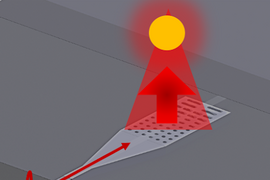
Nano flashlight enables new applications of light
Previous item Next item
More MIT News

3 Questions: Catherine D’Ignazio on data science and a quest for justice
Read full story →

Microscope system sharpens scientists’ view of neural circuit connections

Arvind, longtime MIT professor and prolific computer scientist, dies at 77

MIT-Takeda Program wraps up with 16 publications, a patent, and nearly two dozen projects completed

David Autor named the inaugural Daniel (1972) and Gail Rubinfeld Professor in Economics

MIT graduate engineering and business programs ranked highly by U.S. News for 2024-25
- More news on MIT News homepage →
Massachusetts Institute of Technology 77 Massachusetts Avenue, Cambridge, MA, USA
- Map (opens in new window)
- Events (opens in new window)
- People (opens in new window)
- Careers (opens in new window)
- Accessibility
- Social Media Hub
- MIT on Facebook
- MIT on YouTube
- MIT on Instagram
Feds: Criminals are using 3D printers to modify pistols into machine guns

The same 3D printers that can generate car parts and jewelry are also being used to create small plastic blocks that transform pistols into machine guns, federal prosecutors in Texas warned Monday as the Lone Star State became the latest to go after the deadly "switch" inserts.
U.S. attorneys announced "Operation Texas Kill Switch," a statewide operation to target machine gun conversion devices, also known as switches or auto-sears. The switches – which prosecutors said can be made within minutes using a standard 3D printer – have been used in shootings across several cities, including Houston, Sacramento and Washington D.C.
“We’re here to talk about a roughly one-inch piece of plastic. It looks innocuous enough, a little like a LEGO or a k’nex block. But this one-inch piece of plastic is killing people,” said Leigha Simonton, the U.S. attorney for the Northern District of Texas. “Machine gun conversion devices can turn Second Amendment-protected firearms into illegal weapons of war, and petty criminals into brutal killers. We cannot have our streets turned into war zones."
Local Crime Stopper programs in Texas are offering cash rewards until Aug. 31 for information that leads to the apprehension or prosecution of people who possess switches or 3D printers that are being used to manufacture them. Prosecutors also urged local law enforcement to partner with federal agents on switch cases.
A standard 3D printer can make about 100 plastic switches in 72 hours, according to the Bureau of Alcohol, Tobacco, Firearms and Explosives. and a switch-equipped gun can fire shots faster than the standard M-4 machinegun issued to U.S. soldiers.
Federal agents have seen a spike in switches across the United States. ATF seized 5,454 machine gun converters between 2017 and 2021, up by 570% from between 2012 to 2016. In Texas alone, ATF agents seized nearly 1,000 switches between 2017 and 2023, and half of them were recovered just last year.
Federal gun agents said Monday that the switches are often sold over social media, marketed to adults and juveniles alike.
3D printers used across U.S. to make switches
3D printing is the process of building three-dimensional objects by layering materials using computer-aided design models, according to 3D printing company Formlabs. The technology has been around since the 1980s but recent advances have made the printers more affordable and accessible, allowing them to be used for industries such as healthcare, dentistry, jewelry and entertainment.
Kill switches can be made out of metal or plastic within minutes using a 3D printer, according to prosecutors. They usually slide into the butt of a gun and allow the shooter to fire dozens of rounds with the single pull of a trigger.
In Mississippi, a man was sentenced to 14 years in federal prison last year for converting semi-automatic weapons into machine guns using switches he made from 3D printers.
An Ohio man was sentenced to three years in prison for using a 3D-printed switch on his Glock. Federal prosecutors said he fired in self-defense but still broke the law by owning the switch. Except in very limited circumstances, possession of a switch is illegal, as the National Firearms Act classifies the switch itself as a machinegun, prosecutors said Monday.
In Indianapolis, a man admitted to selling switches he made using a 3D printer and was sentenced to seven years in prison.
“I have been in this business for a long time, and nothing scares me more than the rapid flood of machine gun conversion devices on the streets of Texas and beyond," said ATF Dallas Field Division Special Agent in Charge Jeffrey C. Boshek II. "Rest assured that ATF and its partners are doing everything we can to stop the flow of these things and to prevent the carnage they can create."
States try to combat surge in switches
Federal agents and state authorities are grappling with a spike in switches, which allow a shooter to fire several hundred rounds per minute, ATF spokesperson Kristina Mastropasqua told USA TODAY.
The National Firearms Act classifies the switch itself as a machine gun, and owning a conversion device carries a maximum penalty of 10 years in federal prison and $250,000 fine.
Some states are launching programs to eliminate switches.
Federal prosecutors in Oklahoma announced last week that a man was sentenced for possessing a machine gun conversion device as part of an initiative launched in November targeting switches. New York introduced a bill to ban the sale of "convertible pistols," or guns that can easily be transformed into a machine gun using a conversion kit. Maryland Gov. Wes Moore signed a bill last month that included a ban on switches.
And the city of Chicago sued Glock in March for manufacturing pistols that can easily be converted into machine guns using switches.
"This increasing demand for machineguns by criminal elements does not just present a public safety danger, it is unsafe for law enforcement, as well, who are increasingly outgunned by the weaponry they face," Mastropasqua said. "To be clear, making, selling, and just having a machine gun 'conversion device' is against the law."
- News & Events
- Contact & Visit
- Faculty & Staff
- McCormick Advisory Council
- Departments & Institutes
- Diversity Data
- Faculty Journal Covers
- Areas of Study
- Bachelor's Degrees
- Music & Engineering
- Combined BS / MS Program Collapse Combined BS / MS Program Submenu
- Murphy Scholars Program Projects
- Undergraduate Honors
- Certificates & Minors Collapse Certificates & Minors Submenu
- Integrated Engineering Studies
- Engineering First® Program
- Theme Requirement
- Research Opportunities
- Personal & Career Development
- Global Opportunities
- Existing Groups
- McCormick Community
- Transfer AP/IB Credits
- ABET Course Partitioning
- Enrollment and Graduation Data
- Full-time Master's
- Part-time Master's
- MS with Interdepartmental Minors
- Application Checklist
- Application FAQs
- Financial Aid
- International Students
- Student Groups
- Career & Professional Development
- All Areas of Study
- Departments & Programs
- Apply to Northwestern Engineering
- Faculty Fellows
- Office of the Dean
- Administration, Finance, Facilities, & Planning
- Alumni Relations & Development
- Career Development
- Corporate Engagement
- Customer Service Center
- Faculty Affairs
- Global Initiatives
- Graduate Studies
- Information Technology
- Marketing & Communications
- McCormick Advising System
- Personal Development StudioLab
- Professional Education
- Research Offices
- Undergraduate Engineering
- Newsletter Signup
- Information for the Media
- Tech Room Finder
3D Printing and Citrate Biomaterials Could Allow Dissolvable Stents
Professors guillermo ameer and cheng sun developed a stent showing similar efficacy to commercial versions, the problem.
Implanted stents can develop plaque due to the systemic nature of cardiovascular disease, leading to clotted arteries.
A dissolvable, 3D-printed stent that shows similar safety and efficacy to commercially produced versions.
Why It Matters
Dissolvable, 3D-printed stents could lead to reduced side effects compared to traditional stents.
Professor Guillermo Ameer, Professor Cheng Sun
Implanted stents have saved countless lives. A tiny metal mesh coil, stents keep arteries open for blood to flow that’s crucial to the body to function after a traumatic angioplasty or cardiac event.
That doesn’t mean they’re a perfected technology.
Stents themselves can also develop plaque due to the systemic nature of the same cardiovascular disease they were implanted to counteract. With cardiovascular disease the leading cause of death globally, according to the World Health Organization, the need for more effective stents has never been greater.

Recent work from Northwestern Engineering’s Guillermo Ameer could allow the re-stenting of an artery to restore blood flow with a dissolvable product, a process that currently is not possible.
Using a 3D printing technology called microCLIP developed at Northwestern by Professor Cheng Sun , Ameer produced citrate-based bioresorbable vascular scaffolds (BVSs) with a strut thickness of 62 micrometers, which is thinner than a human hair. Struts of biodegradable coronary stents that were previously available on the market were too thick, and the biodegradable material used to produce them can cause clots and pro-inflammatory tissue responses.
Ameer’s stent can also slowly release the drug Everolimus, which is used to prevent vessels from re-occluding due to scar-like tissue after angioplasty, by depositing a drug- citrate-based polymer coating onto the 3D-printed BVS. This drug is currently used in commercially available metal stents. The BVSs were successfully deployed into an animal’s coronary arteries using a custom-built delivery system and showed similar safety and efficacy to the commercial metal drug-eluting stent Xience in maintaining vessel patency for 28 days.
“Blood vessels treated with our bioresorbable vascular scaffolds were able to regenerate their endothelium, the inner cell layer in contact with blood that when healthy prevents clots.” Ameer said. “The biomaterial and 3D-printing technology we used is scalable and can be mass produced, opening the door to wider use of biodegradable stents that match the dimensions and performance of metal stents. It may also enable patient-specific medical device implants.”
The biomaterial and 3D-printing technology we used is scalable and can be mass produced, opening the door to wider use of biodegradable stents that match the dimensions and performance of metal stents. It may also enable patient-specific medical device implants.
Guillermo Ameer Daniel Hale Williams Professor of Biomedical Engineering at the McCormick School of Engineering and Professor of Surgery at the Feinberg School of Medicine
Ameer is the Daniel Hale Williams Professor of Biomedical Engineering at the McCormick School of Engineering and professor of surgery at the Feinberg School of Medicine. He detailed this work in the paper “ 3D-Printed, Citrate-Based Bioresorbable Vascular Scaffolds for Coronary Artery Angioplasty ,” published online last month in the peer-reviewed academic journal Bioactive Materials .
The director of Northwestern’s Center for Advanced Regenerative Engineering (CARE), Ameer previously pioneered the development and tissue regeneration applications of citrate-based biomaterials, which are the core technology behind the innovative bioresorbable orthopedic tissue fixation devices CITRELOCK, CITREFIX, CITRESPLINE, CITRELOCK ACL, and CITRELOCK DUO. All of these devices have been cleared by the FDA for clinical use in musculoskeletal surgeries.
Sun is a professor of mechanical engineering. His research group is engaged in developing novel nanoscale fabrication techniques and integrated nanosystems for bio-sensing and high-efficiency energy conversion.
Collaboration from a chance encounter
Sun’s research dovetails with Ameer’s work. Around a decade ago, Ameer and Sun began collaborating after meeting in a hallway. Ameer had developed a new type of biodegradable material made from citric acid and was looking into using it for blood vessel support structures. At that time, Sun was working on creating a high-resolution 3D printer designed for tiny, detailed projects.
Over time, we have continuously enhanced our 3D printing technology, improving both its speed and the detail it can achieve. Cheng Sun
The two combined their expertise and technologies. After it took nine hours to print one blood-vessel support system, Sun developed microCLIP, an advanced version of technology created at the University of North Carolina. microCLIP significantly enhances resolution and surpassed existing commercial systems.
Now, Ameer and Sun can produce seven BVSs in seven minutes, and 3D print features as small as 2 micrometers. That high resolution allows them to consistently produce BVS with a strut thickness as small as 62 micrometers.
“By 3D printing via a continuous stage motion, microCLIP effectively handles viscous ink for high-speed printing while also enhancing mechanical integrity, both of which are essential for the success of this project,” Sun said. “Over time, we have continuously enhanced our 3D printing technology, improving both its speed and the detail it can achieve.”
Get our news in your inbox.
Sign up for our newsletter.
Check out our magazine.
Find more in depth stories and get to know Northwestern Engineering.

COMMENTS
COS - the Container Ship. Here is our selection of the best STL boat files, all these beautiful boats are from the 3D file library Cults and are perfectly printable in 3D. This collection includes many free and paid 3D files that will allow you to 3D print at home many variations of boats. Each Cults 3D designer has his own vision of the boat ...
Dragon Force Keel version. The keel box was designed use a DF keel so anyone wanting to get into an RG65 quickly and easily could transfer their DF gear over and start sailing. The Deluxe "Go Fast" set up with 3d printed keel, bulb and rudder. This is a more traditional RG65/65 Class design with a keel to fit.
free Downloads. 1482 "yacht" printable 3D Models. Every Day new 3D Models from all over the World. Click to find the best Results for yacht Models for your 3D Printer.
Download your favorite STL files and make them with your 3D printer. Have a good time! ... Download 440 3D print files tagged with keyword Yacht Advertising Download designs for 3D printer Yacht Filter by: Safe. Free. Best. On sale. With makes. More filters. Sort by:
Pegasus 88m - The Carbon-Neutral Superyacht. The Pegasus 88m is a 3D printed 'superyacht' that even in 2023 only really exists on paper, but is still well worth talking about. Designed as a completely carbon neutral 3D printed luxury boat, it was conceived with nature a the forefront of designer Jozef Forakis' mind.
21 October 2022 • Written by Tristan Rutherford. From spare parts on demand to click-and-buy tenders, 3D printing is transforming how boats are designed and built, discovers Tristan Rutherford. Espen Øino holds a 3D-printed model of a yacht up to his laptop camera. "We use 3D printing for quickly printing out models to evaluate ...
MAMBO, a Functional 3D Printed Fiberglass Boat. Unveiled in 2019 during Formnext, the MAMBO boat was designed by Moi Composites, in collaboration with Autodesk, Catmarine, Micad and Owens Corning. It is 12'4″ (6.5 meters) long, 8'2″ (2.5 meters) wide and weighs about 1763.7 lbs (800 kg). The peculiarity of the project is that it turned ...
Meet MAMBO (Motor Additive Manufacturing Boat), the world's first 3D printed fibreglass boat. It was launched by Moi Composites at the 2020 Genoa Boat Show in October. The Italian start-up drew inspiration from the Arcidiavolo design of British power boating legend Sonny Levi. They spent almost six months running hydrodynamic simulations on ...
Discover free 3D models for 3D printing related to Yacht. Download your favorite STL files and make them with your 3D printer. ... Modeling product engineering and reverse-engineering of Models Boat Yacht Motorboat Oar for CNC machines and 3D printing. Free Jo Yacht III. Free Gift at table stand Turbine Blade Part propeller screw 3d-print and ...
3D Printed Boat: 5 Most Interesting Projects. by Jacob Greenburg. Published Apr 14, 2019. 3D printing has disrupted many industries with the promise of design complexity and short lead times. Join us for this list of the most interesting 3D printed boat projects in 2019. Advertisement.
This LSAM 3D printer is used to create large objects - ideal for creating a full-scale master plug boat hull. The master plug of the hull of a marine boat, including the print, its assembly process, and its trim process took less than ten working days to complete! Once the printing process was done, and the hull was coated with a finish, a ...
On December 16, 2020, we tested a 3D printed motorboat for the very first time by launching it into the Swedish west coast archipelago in the middle of winte...
Discover 3D models for 3D printing related to Sailboat. Download your favorite STL files and make them with your 3D printer. Have a good time! ... repair kit light stop light all-round light boat boat boat lights. US$5.40 Pampero sailboat. US$11 Sailing dinghy 3D model. US$20.54 Sail chafe protector ...
The integrated hull and superstructure will be 3D-printed, an engineering feat given the yacht's LOA stands at a whopping 288 ft (88 meters). The large-scale 3D printing will utilize green hydrogen harvested from environmentally friendly building materials. Above: The glass winged hull is multi-functional. Image via Forakis Design.
A Rotterdam-based 3d printing firm is making waves in the pleasure yacht industry with a bold plan to 3D print 100 luxury boats this year alone. But that's just the beginning. By 2023, they hope to triple production and churn out a whopping 3d printed over 300 vessels.
5. 3D Printed Boat Hull. A 3D printer can help you build any giant vessel you wish, including a yacht. Thermwood company has proved this with its innovative project when it 3D printed boat hull sections from a 51-feet-long (6.4 meters) yacht. Photo credits: blog.thermwood.com.
Print Yourself a Boat. A 3D-printed construction mold has potentially big implications for the boatbuilding industry, but the road won't end there. The next step is taking this technology from tooling and prototyping to production of almost anything—human joints and organs, bicycles, cars, airplanes, surfboards, hardware, and, yes, entire ...
Little boats, massive boats, metal boats, multi-colored plastic boats — if there was a material, color, or process that could be used in 3D printing, it's been made into a boat.
In this video you'll be able to find out how our 3D printed boat has been made. You can read more about it in our blog here:https://arcticchallenge.co.uk/202...
February 3, 2023. Designer Jozeph Forakis has recently unveiled the world's first 3D printed superyacht, the 88-metre Pegasus concept. The yacht is designed to be sustainable and virtually invisible" thanks to mirrored facades that reflect the ocean and sky, mounted to the exterior of the yacht. Reflective facades cover a 3D printed structure.
A time-lapse video of the world's largest 3D printed boat being printed by the world's largest 3D printer at the University of Maine Advanced Structures and ...
The underside profile of the full sized fibreglass boat. The underside profile of the 3D printed test boat. Alongside the inner hull there's a lip with screw holes so I can slot and add extra components. The back of the boat has a raised platform which will allow for mounting of the servos and the motor pod steering mechanism.
Apps. Explore Category. You can print your own R/C racing yacht and have it on the water in a week. Green Hornet is a Footy Class sailboat that can be used for fun in your.
Metal 3D printing has found a way into nautical applications, primarily using titanium and stainless steel to produce boat propellers, hydraulic systems, rudders and foils as well as halyard trays, boat shafts, mounting flanges and custom hull components.
NEW DESIN: https://www.printables.com/model/496157 | Download free 3D printable STL models
This collapsing Katana is designed to be printed as one part. The Replaceable Blade Version is available to my Clubs members. Supports are not required, for best results use a .4mm nozzle. Find detailed instructions on how to print collapsing swords on my website.If this is your first time printing, I would suggest you try the test print first. If you have issues printing, consider the ...
"Class B" Yachts are often called "offshore vessels" and are built for navigating coastal waters within 200 miles of the shore. ... The World's First Glass 3D-Printed Superyacht Concept. This futuristic superyacht design takes a new stance on sustainable yachting. 279 ft. "O'PTASIA" Superyacht For Sale: 5-Star Floating Resort! ...
In the end, the group used their prototype to 3D print arbitrary two-dimensional shapes within seconds. Building off this prototype, they want to move toward developing a system like the one they originally conceptualized — a chip that emits a hologram of visible light in a resin well to enable volumetric 3D printing in only one step.
3D printers used across U.S. to make switches. 3D printing is the process of building three-dimensional objects by layering materials using computer-aided design models, according to 3D printing ...
Using a 3D printing technology called microCLIP developed at Northwestern by Professor Cheng Sun, Ameer produced citrate-based bioresorbable vascular scaffolds (BVSs) with a strut thickness of 62 micrometers, which is thinner than a human hair. Struts of biodegradable coronary stents that were previously available on the market were too thick ...